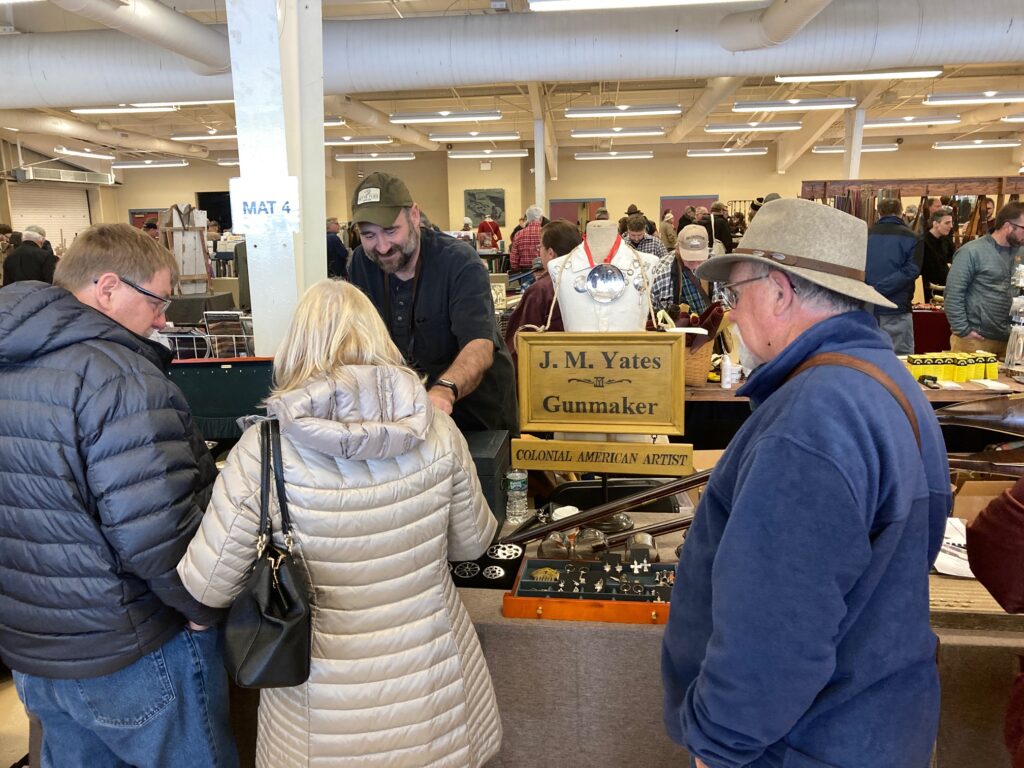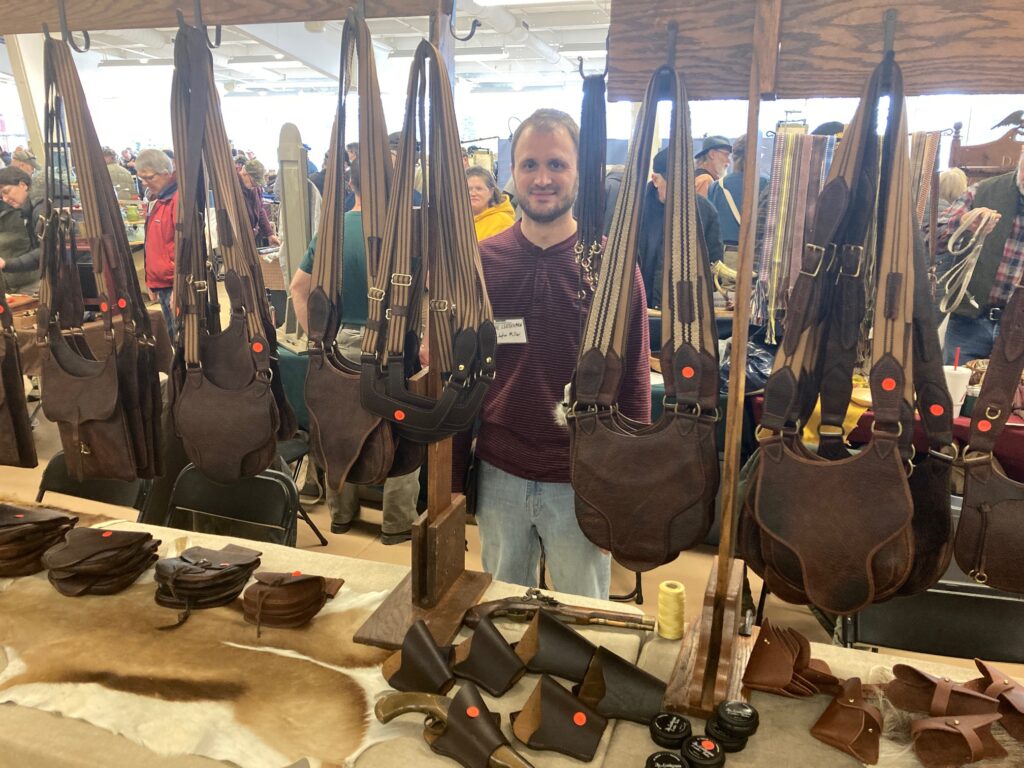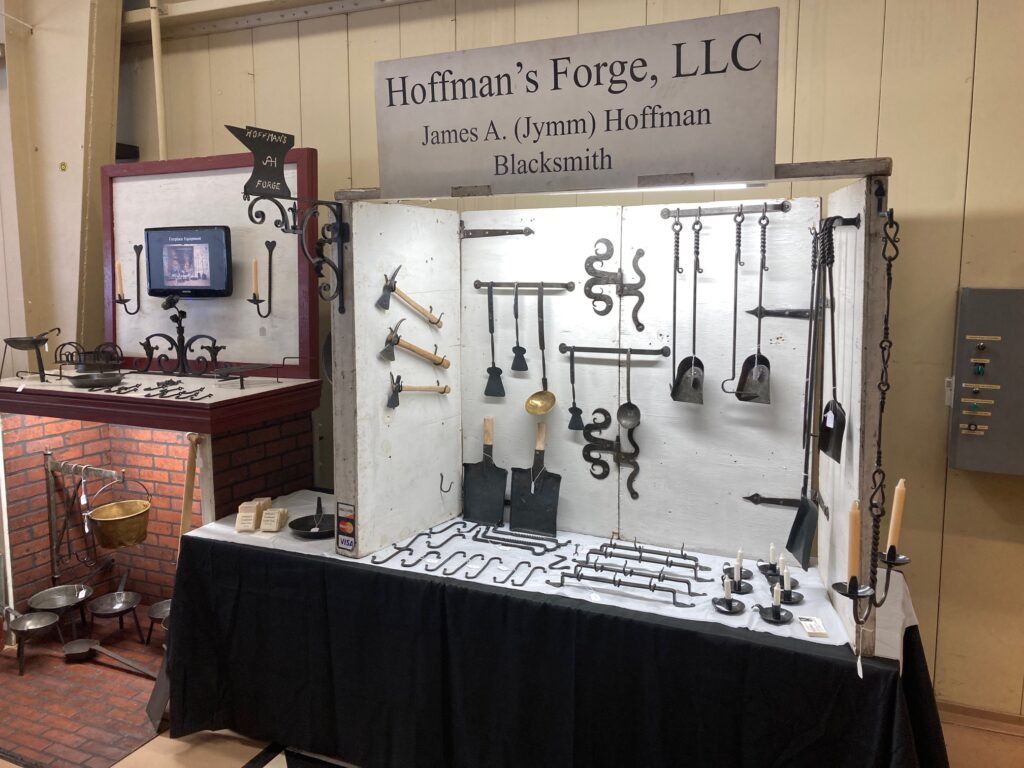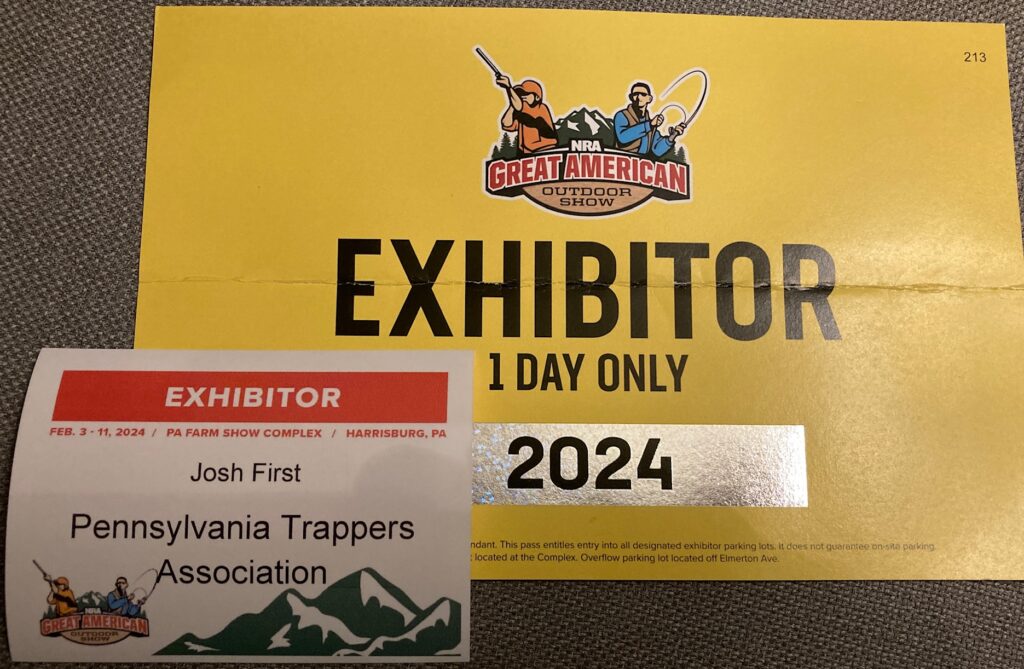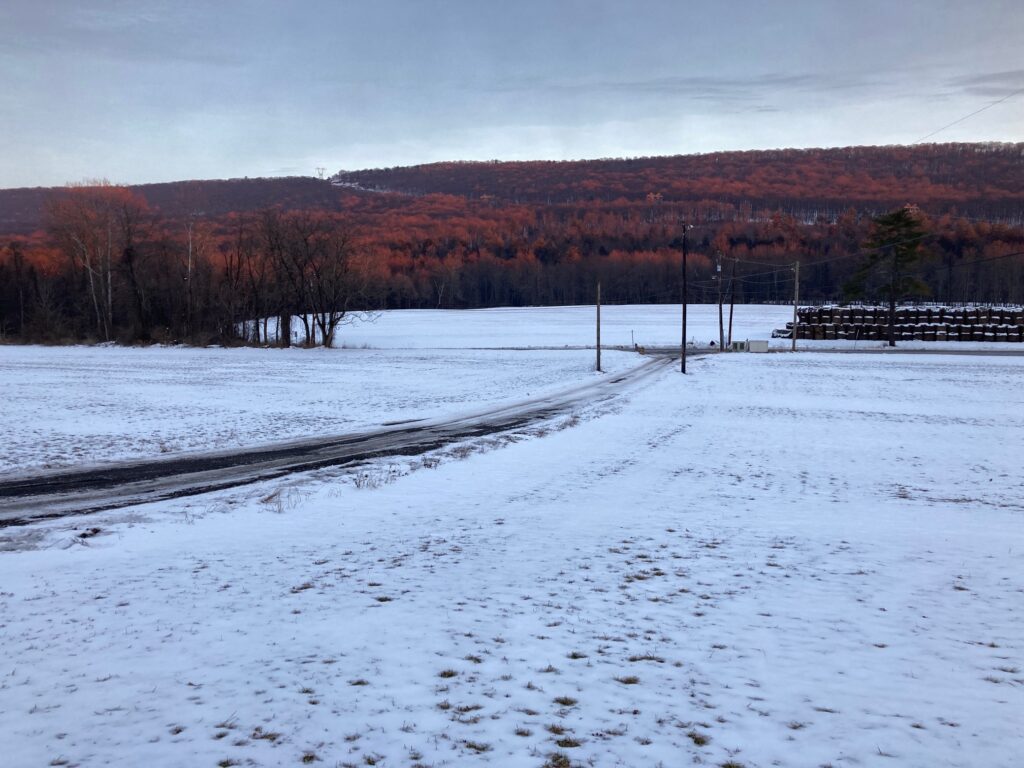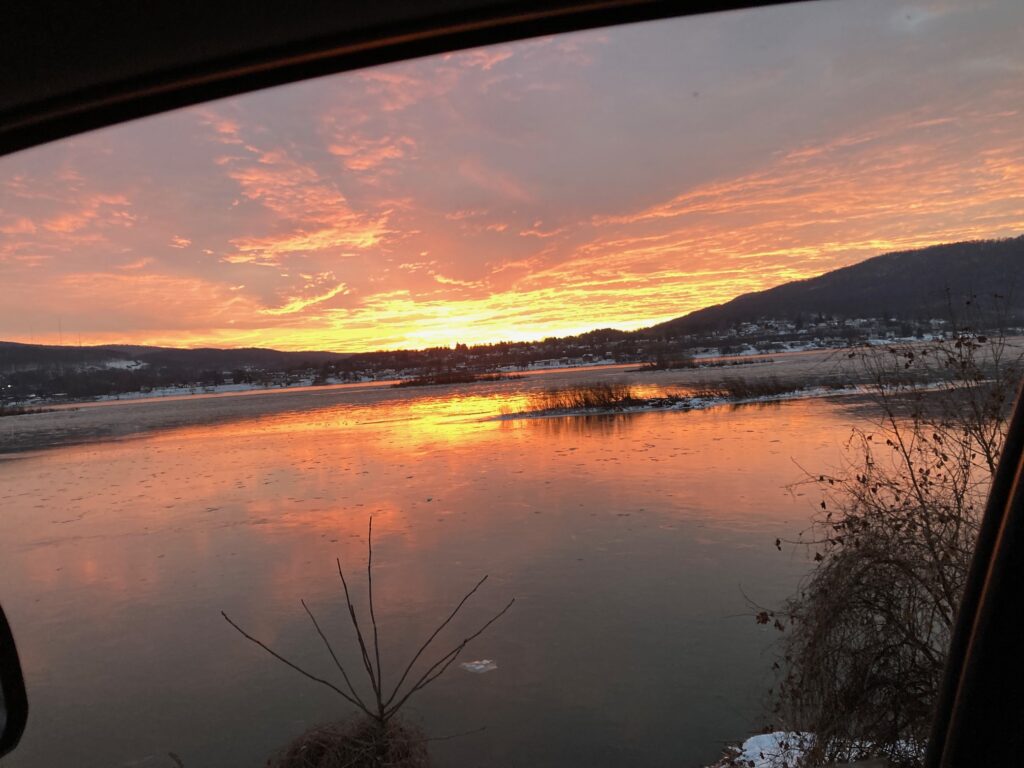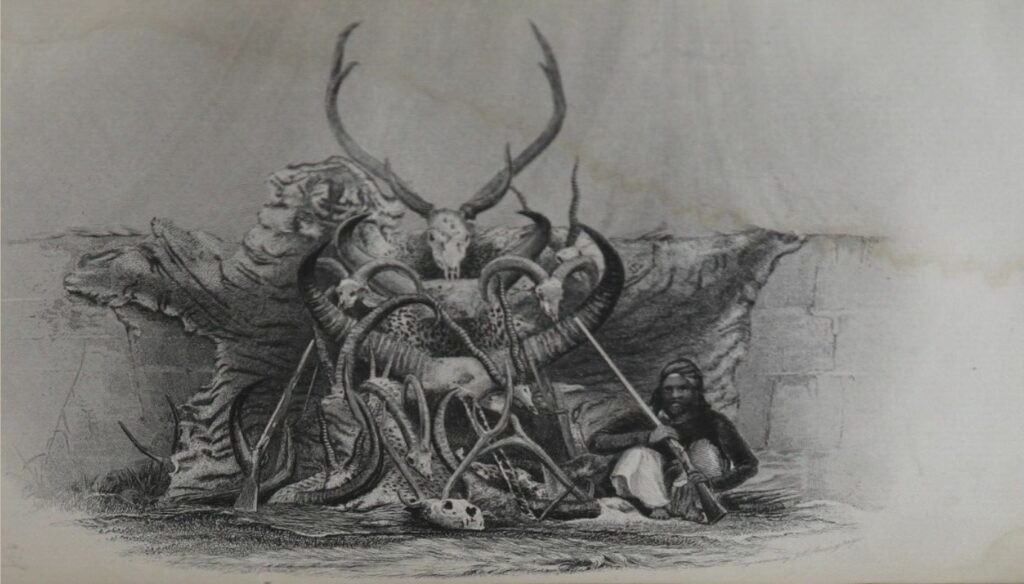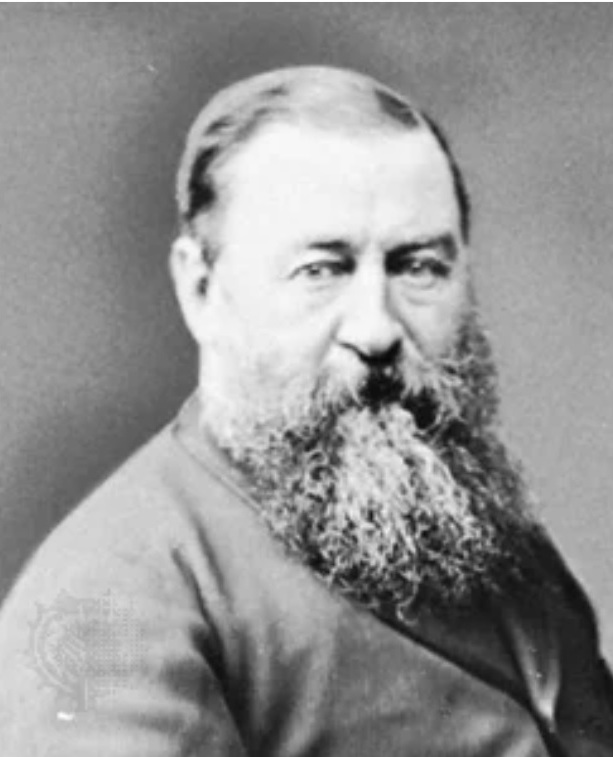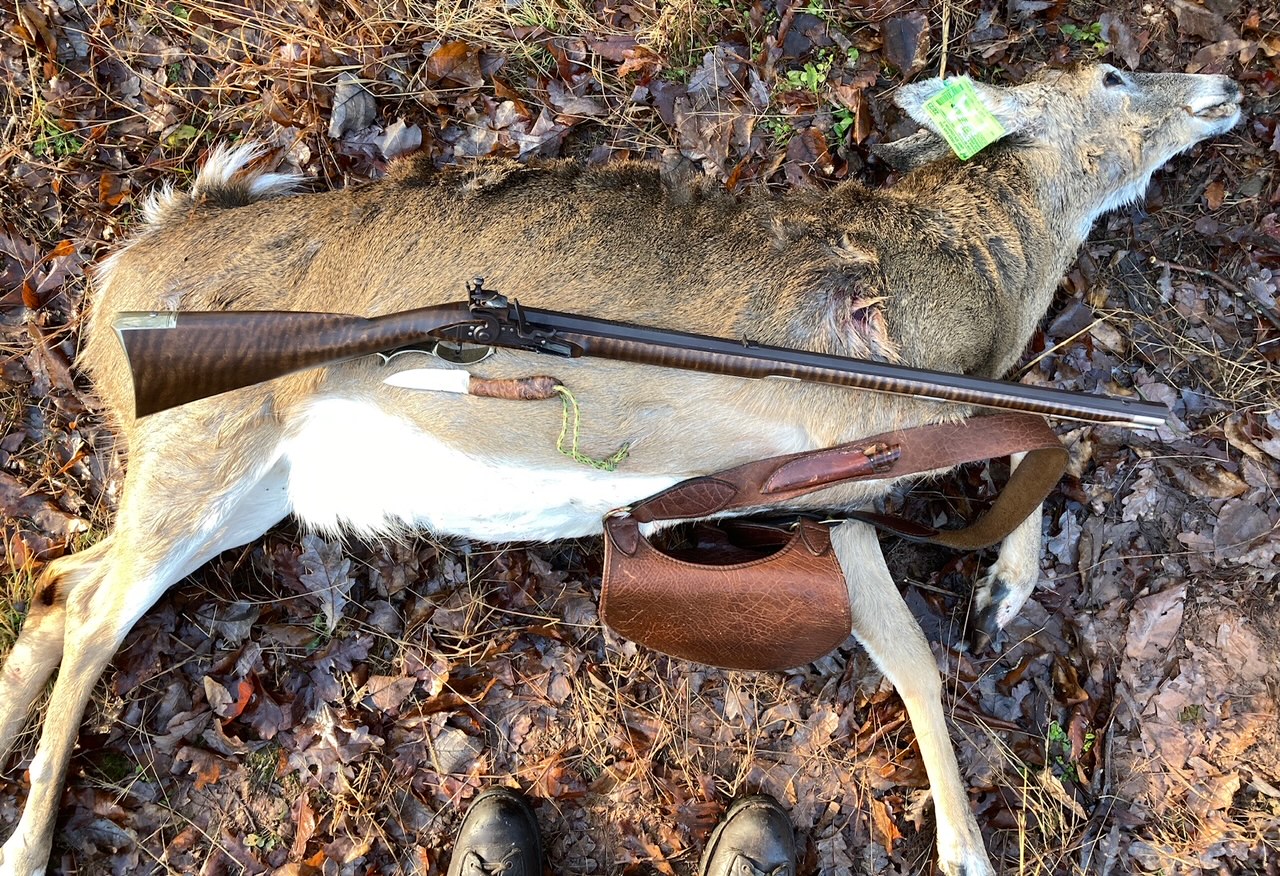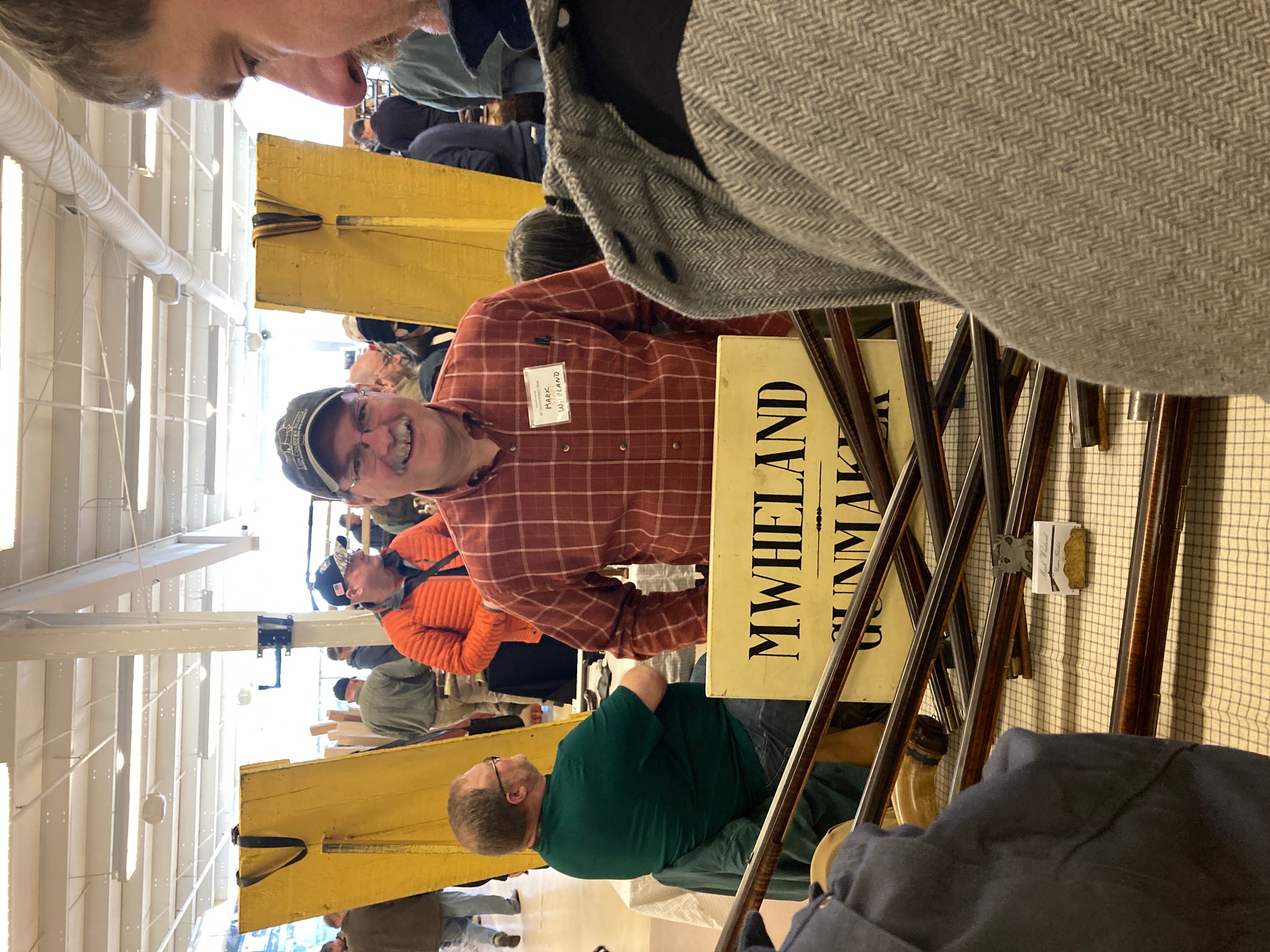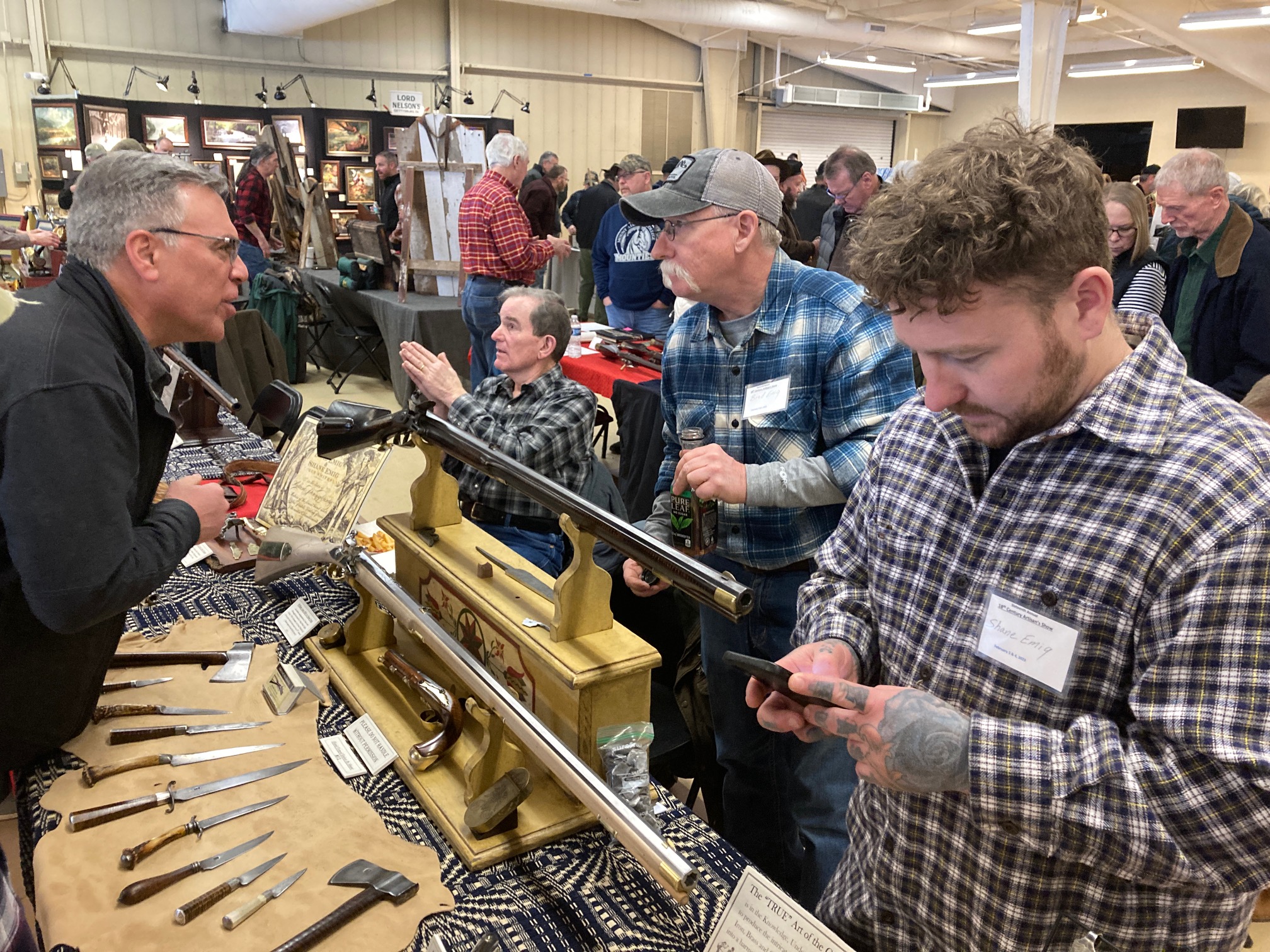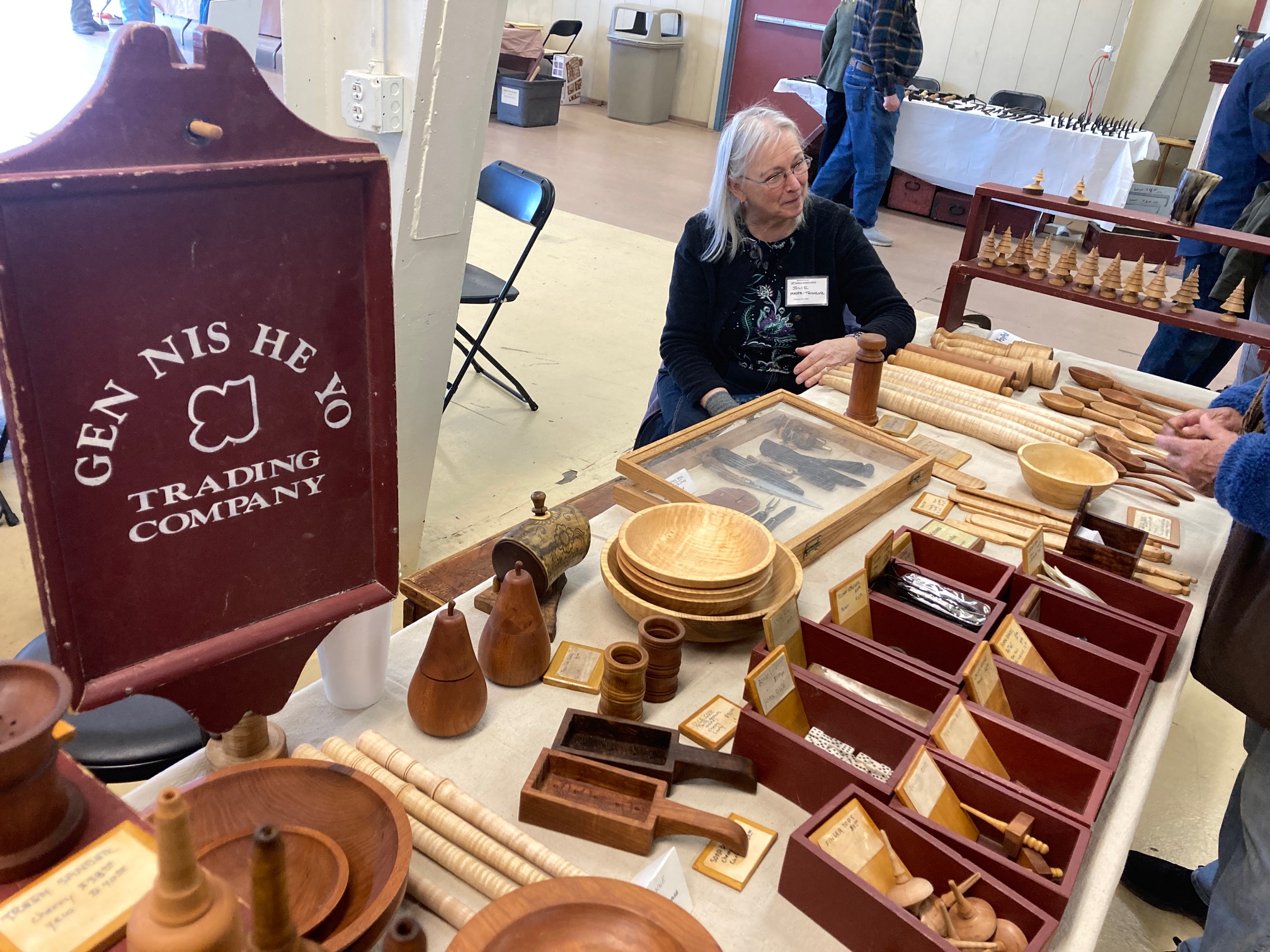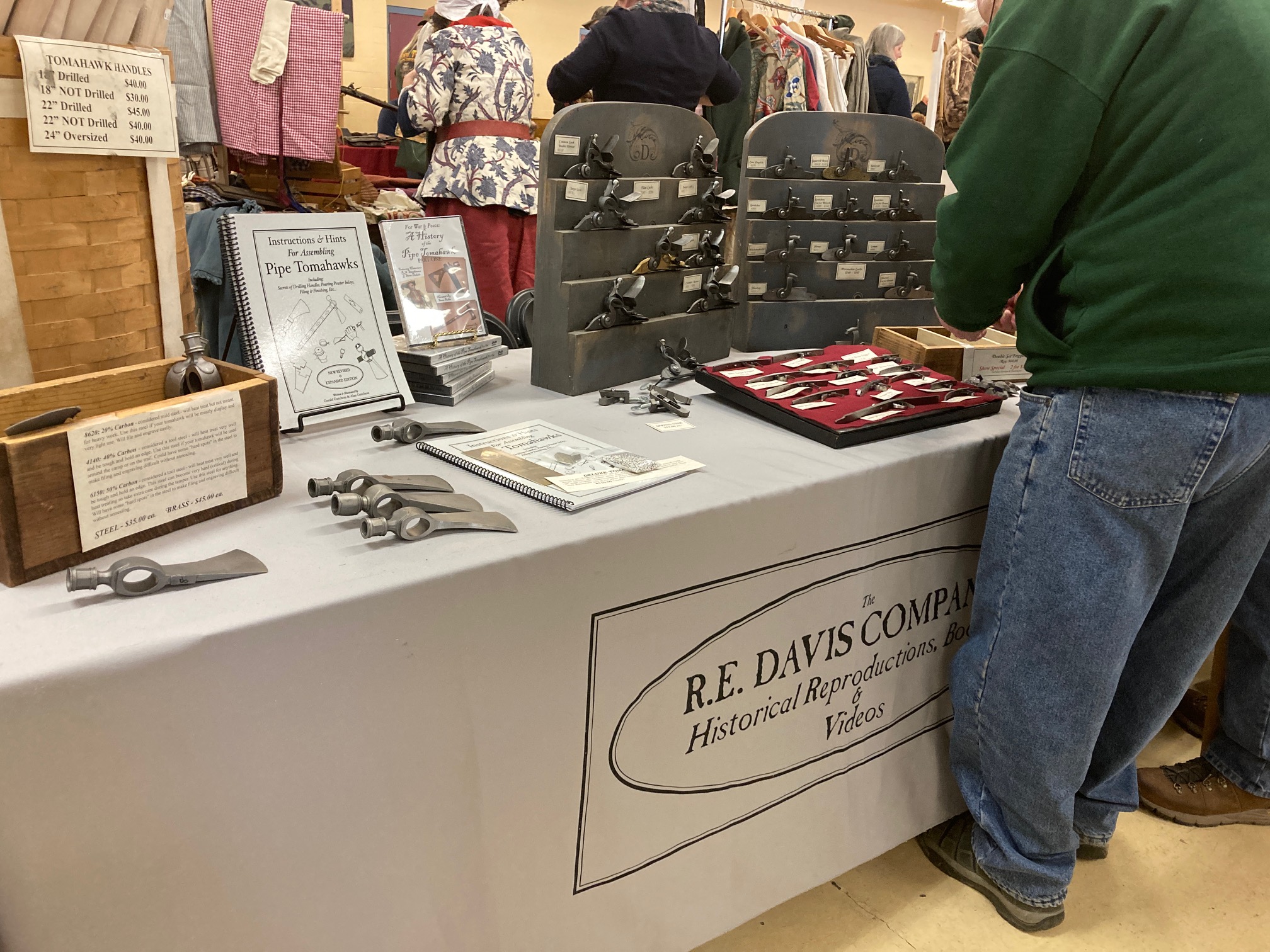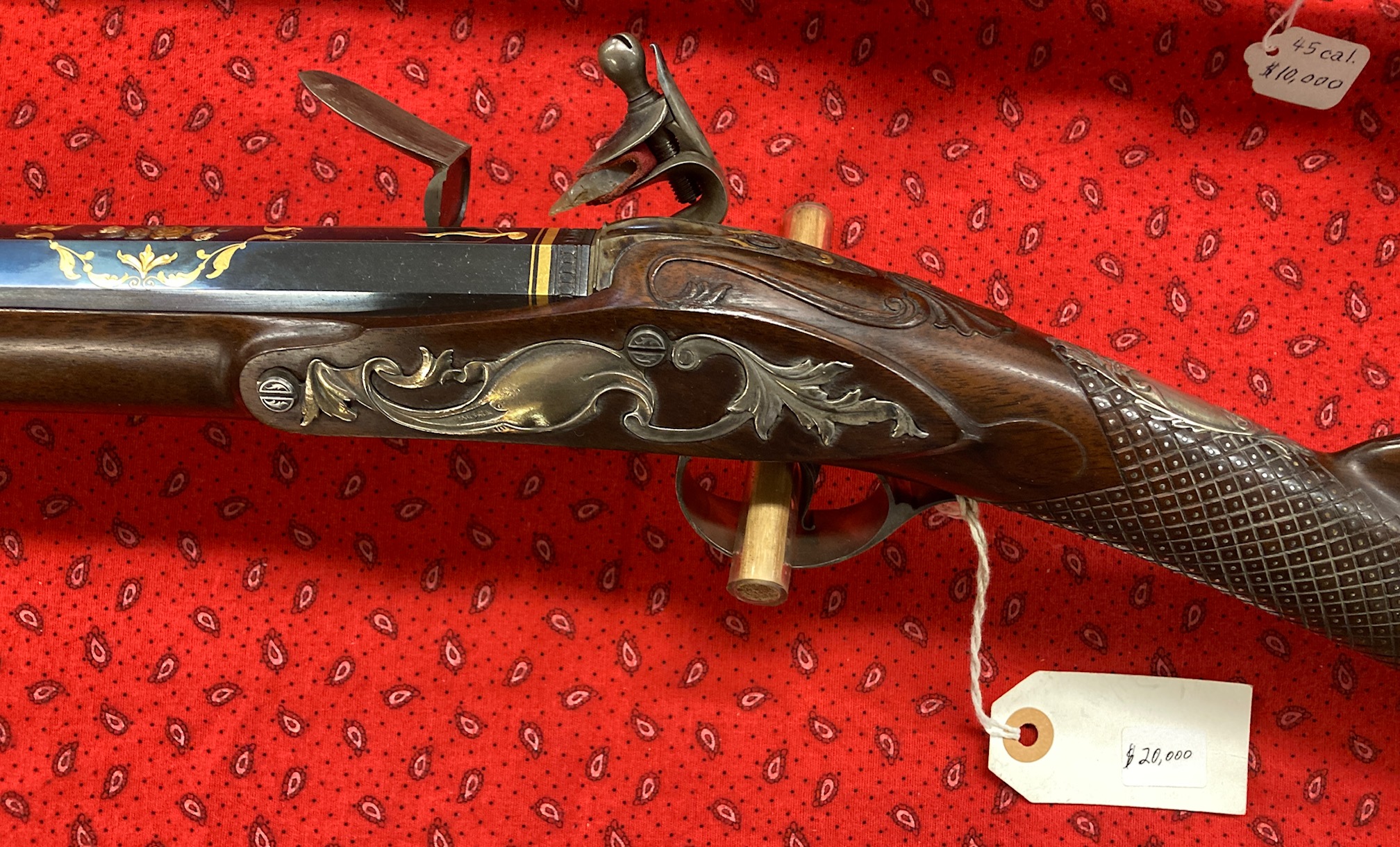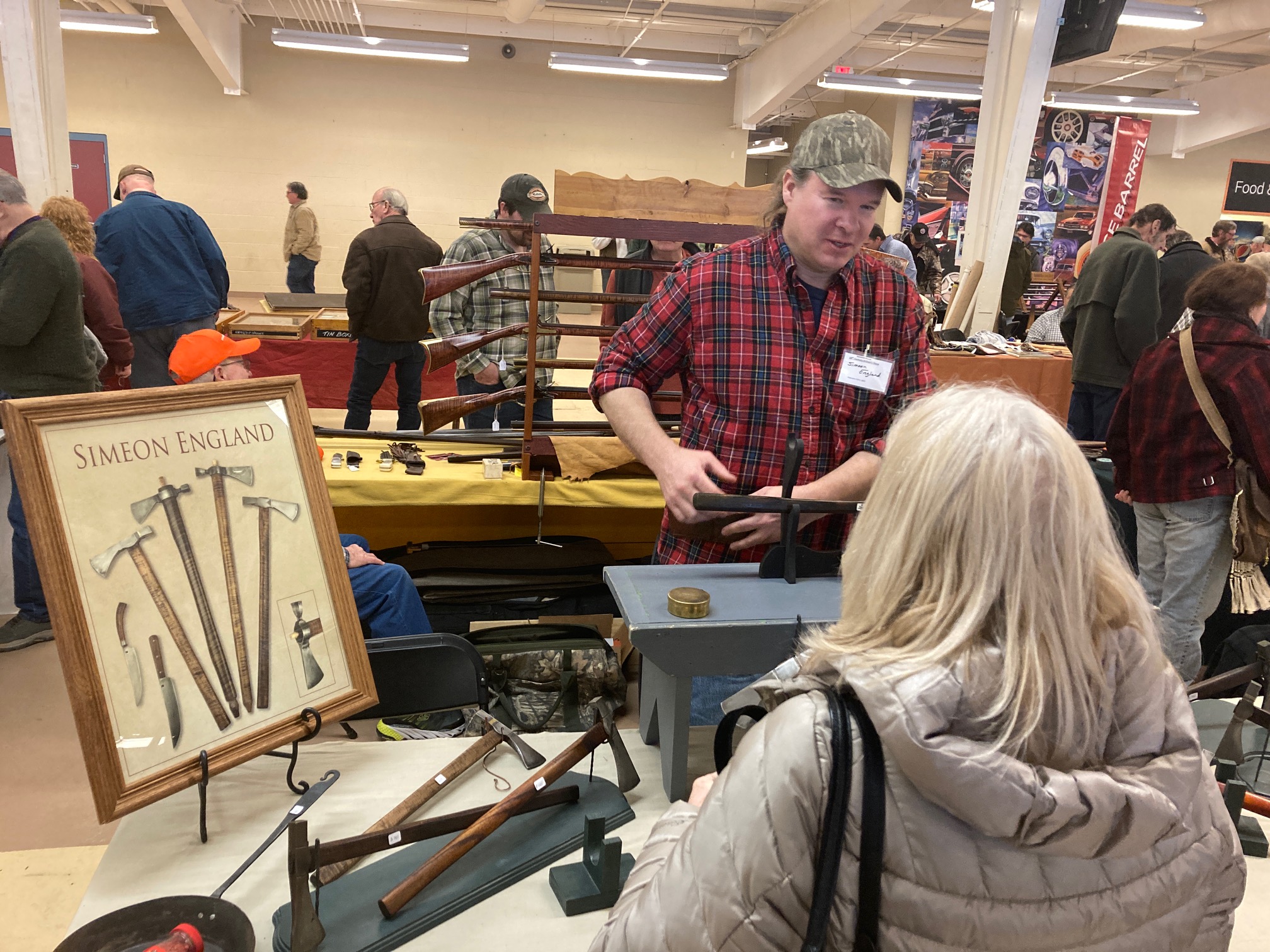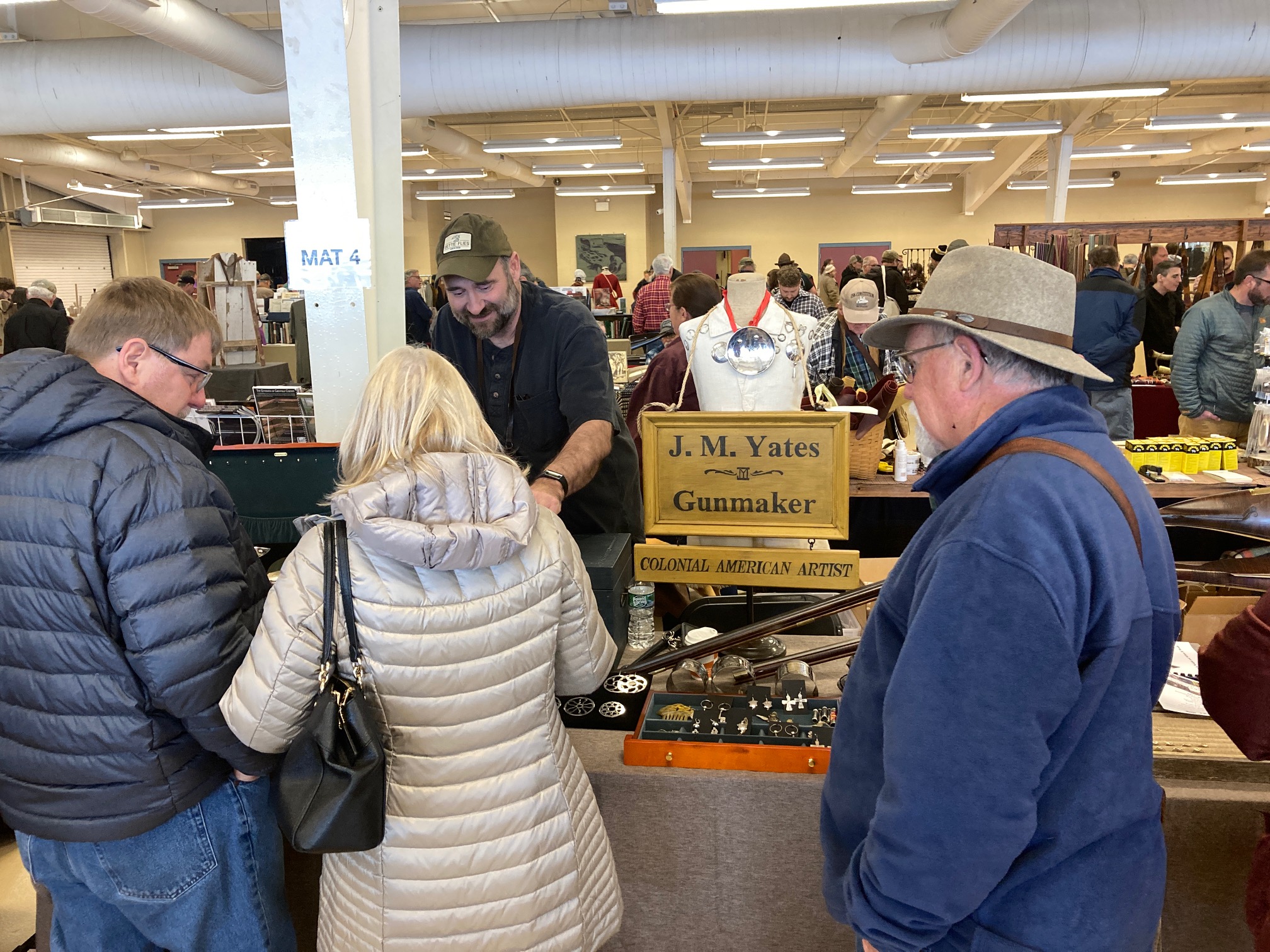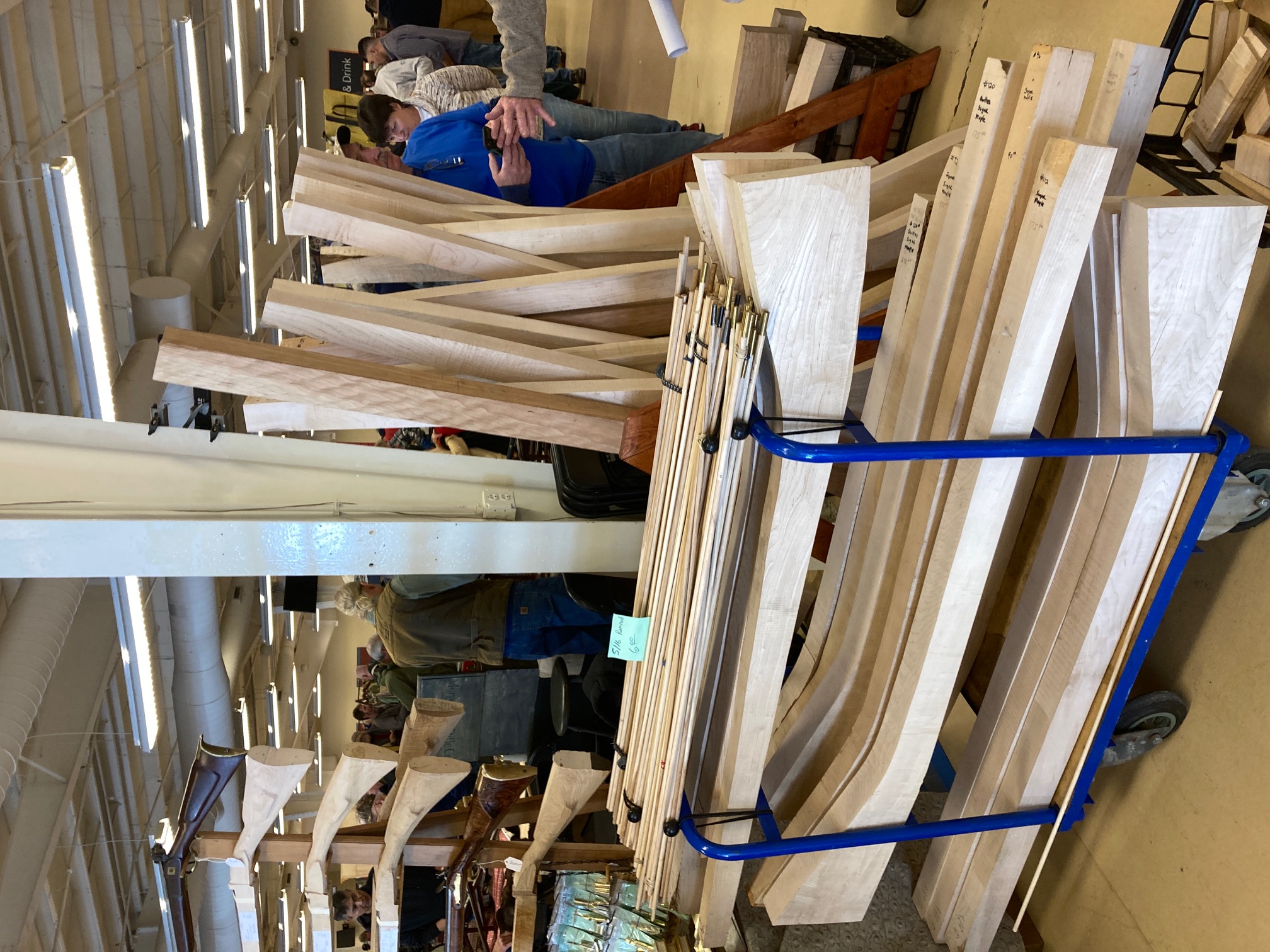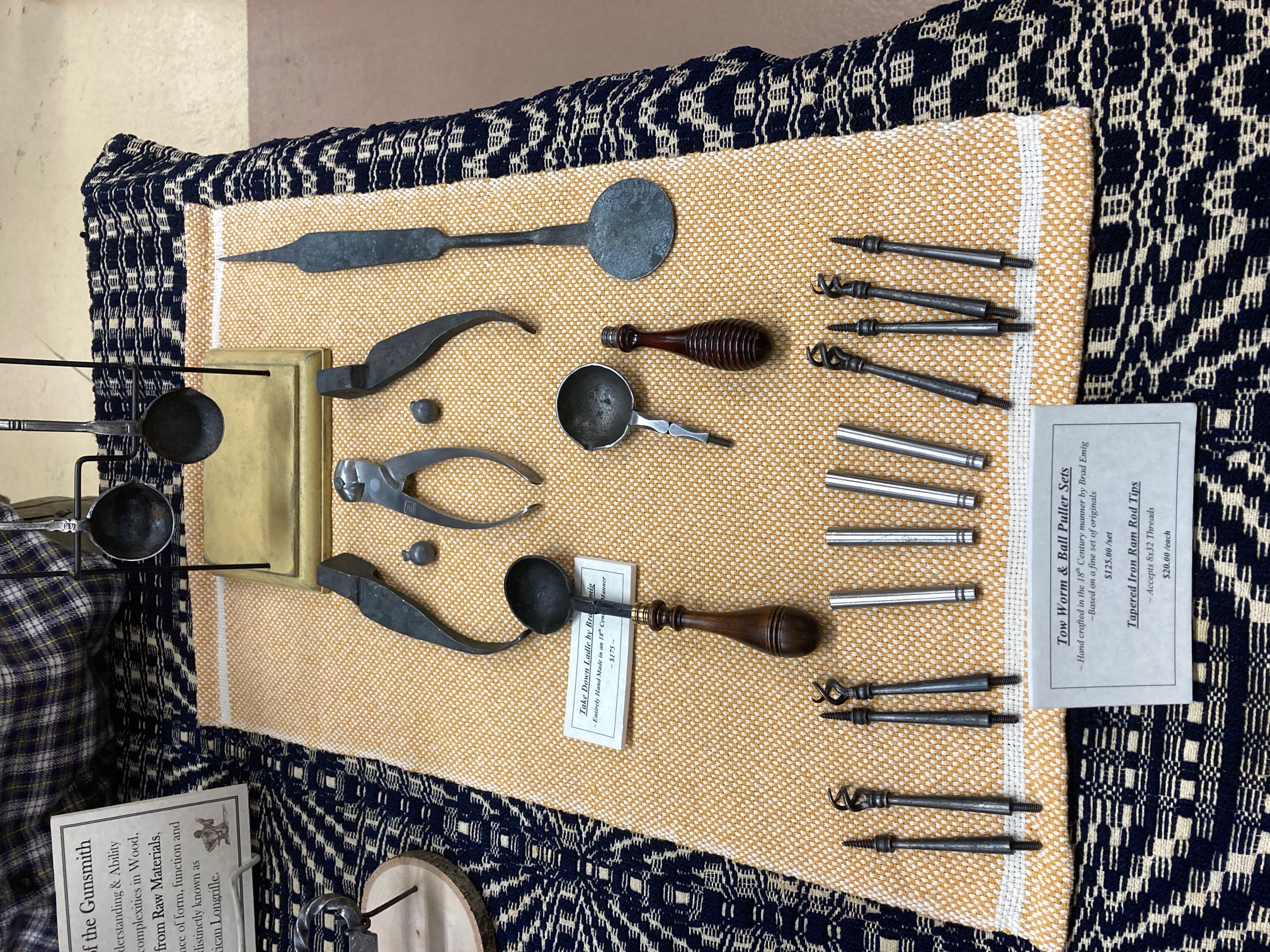Posts Tagged → black powder
Flintlock season recap
- Gunmaker Mark Wheland with the gun of my dreams, a flintlock English Sporting Rifle made just for me
Writing a blog is a delicate walk, because as much as I want to write about the righteous boss daddy treatment President Trump gave to weasel rat dictator Zelensky the other day, I have to stay focused on what our audience of exactly One Person has requested. If I turn off my one reader, then I will literally be writing solely for the air and the stars.
For the record, just because you or I call Zelensky (Ukraine) the weasel rat dictator he is, does not mean that you or I automatically like or support dictator Putin (Russia). Both of these men are in power because they have subverted their nations’ elections, amassed wealth and power at the expense of their countrymen, etc. Yes, Putin is responsible for the war in Ukraine, and yes, Ukraine can and should negotiate a settlement that ends the bloodshed. And yes, Trump should demand and expect to receive rare earth metals in return for all of the taxpayer support Americans have given to Ukraine. This is all normal.
Wanting the war to go on and on with greater bloodshed and destruction on both sides and with more powerful rockets is not normal. That is warmongering.
Anyhow, the late hunting season here in Central Pennsylvania was exciting, but had no filled tags. I used to rabbit hunt a lot, but gave up when the rabbit populations showed signs of vaporizing due to abundant fishers and bobcats. For five or six years now I have hardly seen one rabbit in places where I have created the best habitat, and where rabbits should be swarming. So for many years I have just hunted the late flintlock season for deer, instead, just about daily.
And also trapped for predators, including fishers and bobcats. Not this season, however. On the December flight back from Florida, a man behind me kept coughing and sneezing. He never covered his mouth, and made no attempt to keep from infecting everyone around him. Sure enough, a week later I was showing signs of the same horrible illness half the country has now had, a persistent dry cough and a close brush with pneumonia. Lots of people are getting the pneumonia. So, I was sick as hell during the time I normally set traps, and my kit and steel just sat and sat.
Instead, just about every day after Christmas, I would go out for a couple hours and try to intercept a deer with the new flintlock, coughing quietly into my clothes to muffle the bark. I got off a lot of shots, collected blood and hair, but filled no tags. A new white checked Filson wool coat helped me blend in with the snowy woods.
Made for me by Mark Wheland, the new flintlock is a 62-caliber rifle based on the English Sporting Rifle design, which I have come to admire. It has a 28 inch decently swamped octagonal barrel by Getz from about 15 years ago, a beautiful patent breech made by Jason Schneider at Rice Barrels, a RE Davis late-flintlock era Manton-style waterproof lock, and a gorgeous stock of highly figured and irridescent English walnut. Wheland turned a perfect ebony ramrod, as well as its horn end and its threaded steel connector end.
The Manton-style lock has a roller frizzen, which is both very fast and also very touchy. Hunting in brush without bumping the heel of my hand up against the back of the frizzen would result in some blade of grass flicking it open and dumping the priming powder on the ground. So it requires some special handling, because it is so sensitive.
I also struggled with this gun’s sights all season long, probably also slowly acclimating to the short barrel. This barrel is ten inches shorter than that on my long-time go-to 54 caliber flintlock barrel, that is 38″ long, and my eyes have not yet made the transition. Moreover, the new gun has classic British rear sights, one standing and one folding leaf. The rear sites were conveyed to me with only the most rudimentary and shallow “V” filed in the standing sight, and the front sight was about a half inch high. It was up to me, in a short amount of time, to get this gun sighted in just days before bear season began, which is just days before deer season started.
So I just struggled to get the gun sighted in, and by the time actual flintlock season began, the day after Xmas, it was printing dead center and 2.5″ high at 50 yards. With 130 grains of FFG Swiss pushing the 335-grain lead round ball about 1500 feet per second, I reckoned it was probably dead-on at 100 yards. Or minute-of-deer chest within 100 yards.
I lost track of how many shots I took at deer. Mostly at does. One probably legal buck I let walk past me. Some deer I literally just walked right up to in the snow, and missed, maybe forty yards away. Others I ambushed from concealment on trail crossings, from fifty out to about 95 yards, while sitting. Each miss resulted in a little more blacking being put on the rear sight, a little more color added here or there, and by the end of the season the front sight was filed down to about 1/8″ high and painted bright neon orange. The rear sight has a bright neon yellow inverted V wedge under the V aperature, surrounded by black. I am thinking about scrapping the entire arrangement and going to front and rear fiber optic sights. Old eyes…
One doe was flattened by what seemed like a perfect broadside at 75 yards. I saw her go down through the cloud of smoke, and when I walked up I expected to find her stone cold dead. But while there was a perfect outline of her body in the snow, with plenty of blood, the actual deer was nowhere to be found. With dusk fast approaching, I used my headlamp to follow as far as I could in the snow and the thick brambles, and then went home. The next morning I returned and took up the trail, which resulted in three deer fleeing from fresh beds, one of which had some fresh drips of blood, but not much. Not even the coyotes would end up eating her.
My last shot of the season was taken like a mortar, at the biggest buck I have ever seen in the wild. He was just a bit over 200 yards away, and had been spooked out of his hidey nook by my prowling. When I snuck back towards the anticipated cut-off, he was indeed standing right there, looking all around, on high alert. While down wind, I was as close as I could get without being seen. So I took some pictures of him, which of course did not come out well, and then took careful aim with plenty of “Kentucky elevation” and let ‘er rip. At the shot he flew away with wings, and on my follow up I found where the big lead ball had hit the ground at plane, leaving a 20-foot-long long streak through the snow and dirt directly in line with the buck’s shoulder, but about 20 yards too short. His tracks were among the biggest I have ever seen. Guessing a 200″ buck.
I have a lot more practice to do with this gun.

What looks like a shallow white “W” is just the higher visibility part of the huge buck’s enormous rack

Nice view down into the woods, perfect for a flintlock. Yes, the barrel key is loose, which accounted for two missed shots

Hunting around an enormous buck capable of leaving big rubs like this one is excitement enough. Actually seeing him and getting a shot…even the miss is the highlight of the season
summertime fun! great ETAR & Kempton shows

Big Jim replaced the arrow shelf material on my bow as only one of the top archery professionals can

Conservationist and outdoor leader Rose Anna Moore gave a fascinating lecture about her experiences as a wilderness survivor contestant and a mom and entrepreneur.






The Eastern Traditional Archery Rendezvous this year was the biggest, most successful ever. The Ski Sawmill location is far superior to the old Denton Hill State Park. Much more flat ground, much easier to access everything. Thousands of archery fiends camped out, and when I left campfires were just breaking out everywhere, their aromatic smoke resurrecting memories from childhood.
First time I have had to park way out on the landing strip, and take the hay wagon shuttle. Lots and lots of people!

Colorful character Jerry Heister is a super talented artist who works in all kinds of mediums, including horn, wood, metal, and raucous humor
Big vendors were there, including Big Jim’s Bows, KUIU hunting clothing, etc. Big Jim replaced the original arrow shelf padding on my Mike Fedora bow, showing me the advantages of simple Velcro®️in lieu of the original “Bear Hair” that had been put on by Fedora when he made the bow in 2001. Big Jim said he had sold all but a few of the bows he had made and brought with him on just the first day of the show.
At the KUIU tent I yukked it up with the guys and bought an Axis outer shell. KUIU makes their clothing super tight, and I ended up with a 4XL…. 😬. Unsure how to interpret this data. Let’s see how this works in Alaska this Fall, where water resistance if not waterproof is a necessity whenever you are outside. I hunt and fish outside. Especially in Alaska.
I did some shooting, and was generally happy with my accuracy, though I did not take a shot at Bigfoot, who was at least 150 yards out, if not farther. That’s just too far for my ability. Can you find the Bigfoot target in the picture of the archery range?
Saw some friends and acquaintances, maybe even a family member, and soaked up the breezy sunshine surrounded by wholesome families and kids.
Topped it off with a fascinating lecture by Rose Anna Moore, a pretty and down to earth mom and conservation entrepreneur and leader who competed in one of those “survival” tv shows several years ago, and whose body is still recovering. Guess those shows are real, after all…Rose Anna almost died because of her competitive spirit being boxed out by Canada’s ridiculous bureaucratic nonsense. She wasn’t allowed to eat squirrels, or even mice! Not even salmon…guess the producers of these survival shows are not the smartest people. <sigh> city people…
The next day I was at the Kempton Gunmaker’s Fair, where I was able to replace a flat powder horn I apparently left way up on our hillside in Pine Creek. Colorful character Jerry Heister made a new one almost as nice as the one he made me ten years ago.
Checked in with Mark Wheland to see how the 62 caliber BSR is coming along, and met a lot of friends along the way.
Topped off Kempton with a long and really helpful lesson in forging a knife by blacksmith Tyler Mazer.
The summer is going to be over in a few weeks, so you had better get a move on with your own plans. By the way I am seeing hardly any berries left anywhere.
It’s summer, have fun

Good antidote to miserable politics, your garden. On the left are cut up peaches from one of our trees, destined for the chest freezer. On the right are a potful of ripe tomatoes and basil, plucked from the garden this evening and destined to become a delicious red sauce.
I agree with you, politics is sucking all the air and happiness out of people. Whether you live in Ireland, where the government is clearly working overtime against the vast majority of the citizens who live and come from the Emerald Isle, or you live in America, where the government is clearly working overtime against the interests of all of the people who grew up here or who immigrated here legally, it is evident that democratic processes in every single democratic nation were used to achieve undemocratic outcomes that favor big money interests.
If you like your democracy, and you want to keep your democracy, it is now clear that you will not be allowed to have democracy unless you become just as ruthless as the evil people who are ripping you off.
Wasn’t the whole purpose of representative government to avoid physical violence for political control, and use voting as a substitute? For the better of us all? I guess that attempted murder of President Trump opened a lot of eyes… looks like some bad people are desperate to keep him from getting into office like The People want.
Well, it’s summertime and despite the scary efforts to erase democracy worldwide, we can and should still have fun. Summer county fairs are a wonderful place to spend a hot afternoon and cool evening, with live music and naughty food. I am looking forward to the Eastern Traditional Archery Rendezvous, which starts this Thursday in Oregon Hill, at the ski place thing. Traditional Archery people come from all around the world to just fling arrows at targets (my favorite is the 3-D Bigfoot at 85 yards), buy new or replacement kit, get a new bow for a special upcoming hunt, or to listen to the archery greats explain their techniques. There’s also trick shooting demonstrations, which really will take your breath away. Serious talent.
And running simultaneously, unfortunately, is the “new” Kempton Gunmakers Fair, in Kempton, PA. This is the replacement for the very long running Dixon’s black powder Rendezvous in the same area. I intend to take some blacksmithing classes on making traditional knives there, as well as check up on how the 62-caliber flintlock British Sporting Rifle is coming along. It’s been in the works for 18 months, so it must be really taking shape. The man making it is a very well known black powder gunmaker. For those who don’t know, these are the kind of guns that require the old fashioned gun powder to be poured down the barrel, and which often have flintlocks with a real piece of flint that makes a spark that lights gunpowder in a pan (“he’s just a flash in the pan” comes from a flash that failed to ignite the main charge of powder you had just poured down the barrel). These are not real dangerous guns. The last time one killed somebody was in 1812 or thereabouts. Although Mark Twain did have a humorous warning about “safe” old guns hung above the fireplace accidentally bagging grandma in her rocking chair. They are not toys, but they are not weapons of modern war, either.
Anyhow, go on an git, git on out to the local county fair, or to some summertime evening live music. Maybe there’s a park waiting for you and someone you care about to go have a picnic. Summer’s just about 2/3 over, and you better git while the gittin’s good.
I have been enjoying working in my garden and fruit trees, when I don’t have to share them with swarms of vermin. Today I watched birds eat four beautiful peaches, despite my attempts to drive them away. The squirrels are on temporary hiatus, probably scheming to come grab everything tomorrow morning before I wake up.
Two great shows coming up soon!
Two great shows are coming up soon. If you live in central Pennsylvania, then fortunate you. If you live farther out or even far away, even out of state, both are worth traveling to, even from far, far away.
The first show starts this Friday, the 18th Century Artisan’s Faire, now (as of last year) held in Carlisle, PA, at the Carlisle Expo Center at 100 K Street. It used to be called the Lewisburg Show, because for decades it was held in Lewisburg, PA, along Route 15. The Carlisle Expo Center is SO MUCH BETTER than the prior hotel venue. I went to this show last year and could have easily spent both days there. Better lay-out, better room, more room, higher ceilings and far better lighting.
If you are afflicted with history-itis, with a passion for hand-made tools and utensils of all sorts, including eating utensils like forks and knives and plates, with blacksmithing and historic reenacting, with hand-carved curly maple furniture and gunstocks, leatherworking, with anything black powder or flintlock or percussion, with 17th and 18th century clothing, then this show is for you. I have been attending for I don’t know how many years, a long time, and every time I go it’s worth it. The nationwide talent that is assembled at this show is amazing to experience.
The second show starts this Saturday, the Great American Outdoor Show. It is held for the whole week in Harrisburg at the Farm Show Complex on Cameron Street. This is the “new” show built on the ashes of the old one, which I helped end by starting a boycott.
The prior show was run by a British promoter, and they had no feel for America, Americans, guns, gun rights etc. In the immediate political backwash of another Democrat-run mass school shooting, that British promoter tried to prohibit exhibitors from having AR-15 platform rifles. That set off a slight negative reaction among the paid participants, advertisers, and attendees that culminated in the boycott, which ended the show that year. And it ended that tone deaf promoter’s role in the show ever-after.
In the press interviews I did about shutting down that show, my favorite quote was “The British did not understand Americans in 1776, and they still don’t understand us in 2012.”
To which I think we can easily now add the entire Democrat Party, because it is openly and officially the political party of big government, of citizen disarmament and gun confiscation, of digital currency and your money control, of high taxes, of speech control, of thought control, of censorship, of car control, of health care control, of Covid lockdowns and private citizen movement control, but not USA border control.
Nope, under the Democrat Party the American border is wide freakin’ open to tens of millions of anyone and everyone from around the world.
So, go to these two shows. Both are very family friendly, regardless of what your family members each like. You will be really happy you did go. Enjoy America and freedom while you still can.
On Friday and Saturday you can rub elbows with gunpowder horn makers, flint knappers, flintlock and percussion rifle makers, black powder bag makers, historic dress and bonnet makers, tri-corner hat makers, and blacksmiths.
On Sunday you can go to the Farm Show Complex and see the whole world of tactical socks and vests, endless semiauto blast-em rifles as well as very cool historic lever action rifles and Wild West revolvers, bushcraft duck calls, high fence deer hunting legends and other TV created one-dimensional personalities, useful ATVs, fabulous boats, and cool end-of-the-world survival RVs, high tech synthetic and high tech wool outdoor boots and clothing, hunting guides from all around the world, and all kinds of fishing stuff. The Great American Outdoor Show really is an amazing experience. I highly recommend it.
I myself will be both a visitor and a volunteer at the GAOS. After many years of volunteering at the show and its predecessor, I took 2021-2023 off. This year I will be volunteering one or two days with the Pennsylvania Trappers Association, a wonderful conservation group of which I am a Life Member. Come on by the PTA booth and chat with us!
Reviewing the Marlin 1895 SBL
I have had some Marlin rifles, and what American deer, bear, or small game hunter doesn’t have one or two along the way in a life in the woods. But I never got so excited about one of them that I needed to join an online forum to discuss them and compare notes on handloads (handloads are non-commercial ammunition loaded by hand by the end-user, on a personally owned loading press, allowing the shooter to tailor ammunition to exacting tolerances and specific uses). This changed with the purchase of a new Ruger-made Marlin 1895 SBL, which I am really liking (after sending it back for much needed warranty work immediately after taking possession of it brand new in the box from the factory – ahem).
Overview
The new Ruger-made Marlin 1895 SBL (https://www.americanrifleman.org/content/2023-rifle-of-the-year-marlin-1895-sbl/) is a rugged, well designed firearm that I bought for two reasons and for two uses: It is fast shooting and unusually hard hitting within 50-60 yards for a sporting rifle, and I cannot think of a better rifle to hunt with on our bear drives here in PA and on bear hunts in Alaska.
After several months of ownership, here are my experiences with this gun.
Despite purchasing it brand new from the factory, I returned it to Marlin one day after picking it up from the gunshop, because the lever screw backed out, the action kept binding up, it was difficult to cycle the lever, had lots of sharp metal edges, and proud wood around the tang. This gun should have never been allowed out of the factory in the first place, and yet the buyer demand is so high that there must be pressure on the factory to just sling them out the door. According to reports made by other new owners, my experience is not unique. Ruger Marlin is going to kill their golden goose if they keep up this sloppy behavior. The gun is being sold on its presumed high quality.
The “Improved, slimmer” Forearm
While Marlin touts that the new, improved 1895 SBL forearm is slimmer than the old one, it is still too fat. This forearm is hardly easy to handle, and is not slim by any definition. It can easily use another 1/8” shaved off each side, or more, and tapered, like a shotgun forearm. That is, if you mean what you say about the forearm being easier to handle, dear Marlin.
Floppy Trigger Syndrome
The SBL’s factory trigger is pretty good, though it could be better. It is almost crisp, with a very defined and short step of creepy travel, and no stacking, but is a bit heavier than I and other users would like. It works well as a hunting trigger, which is all it really has to do anyhow. I don’t think this trigger was designed by a liability-minded lawyer. Other reviewers have reported that their 1895 SBL triggers were coming in between 5.5 to 8.5 pounds pull weight, and I am just guessing that this particular gun’s trigger is around 5.5 pounds. My preference would be in the 2.5-4.0 pound pull weight range, but I do not believe this factory trigger is adjustable. So “it is what it is,” as that tired old cliché goes, though there are superior aftermarket triggers available (https://www.wildwestguns.com/product/trigger-happy-kit/). One thing I do not like about the factory trigger is that it flops around and can make a tiny metallic sound. It would be preferable that it be stationary, locked in place, and not make noise. Because it’s on a hunting gun, and hunters require stealth. Nonetheless, the factory trigger works well as-is, and it certainly could be a lot worse.
One Rugged Beast
The SBL is one well made and tightly built rugged beast, and I think this is one of the main reasons for its popularity. Stainless steel and high tech laminate wood on anything, especially a firearm, mean it is made for southeast Alaska, at least, or anywhere else that is physically challenging and frequently wet and/or loaded with salt air. This is a rugged gun that should take all the wet and salty environment that could ever be encountered under normal hunting or camping conditions. The stainless steel does result in a shiny, reflective presence, however, and maybe too shiny for a hunting gun. Someone out there is going to bead blast their SBL for good reason, and thereby start a trend.
OK, I Guess Modern Hunting Guns are High Tech
Because I am a devoted black powder shooter and hunter, and because the year 1895 was the pinnacle of firearm development for people addicted to antiques and history like me, and because I prefer break-action single shots and double rifles over all other types of sporting guns, and because nicely blued or blacked steel with figured walnut make the most attractive firearms, I have heretofore been positively allergic to stainless steel and plastic modern guns. Everything about them just irked the crap out of me. Modern sporting firearms are just not appealing to me on any ground, most especially because nearly all of them are just plain ugly as hell. But in recent years I came to recognize that the most beautiful sporting arms can and likely will be destroyed by extended visits to places like Alaska, and so I came to a form of détente on this conundrum by recognizing the unique abilities of the SBL, and only the SBL. Its traditional lever action form is recognizable as quintessentially American, even in stainless and epoxy laminate.
The SBL is not only stainless steel and laminate wood that you can dig out a fox hole with, it also comes with a screw-off end cap for attaching a sound suppressor or a muzzle brake. Neither of these make any damned sense to me on this gun in the relatively quiet out-of-the-box 45-70, but whatever. People who are already crazed about suppressors and high tech gear-queer technical gobbledygook like muzzle brakes on deer cartridges will have all the joys of toys their little flaming hearts desire with this rifle’s little bells and whistles. Leave me out of it. To me, this is just a reliable, fast action mechanical gun in a caliber I can rely on in close-quarters grizzly country, end of technical story.
However, the factory attached Picatinny rail is pretty intriguing, even if it is also downright fugly as sin. It blows up and sets on fire whatever nice lines the 1895 SBL had to start with, but it is a valuable addition for those who use scopes and red dots and other training wheel tubular sighting contrivances on guns that don’t need them. I myself have not yet needed to use a scope on any gun I own, much less this lever action, and so this Picatinny rail is of no use to me. But in the interest of not “fixing” things that are not broken, I will leave it attached to my rifle and just hope it stops jabbing me in the proverbial eye every time I look at the gun.
This Gun Can SHOOT
Accuracy out of the box indicates these are being roughly sighted in at the factory with a laser bore sight, which is a good place to start shooting it in for hunting accuracy after you take possession of it. Do not take your 1895 SBL hunting out of the box! A fair amount of adjusting the rear peep sight for windage and elevation was necessary to get this one dialed in point-of-aim at 70 yards, which is the likely range I will be using it (see below for the deer I took with it this week at a measured 151 yards). Four shots were needed to get it centered, using the Hornady LeveRevolution 325 grain FTX, which is pretty much the standard factory ammunition designed for this gun.
Reloaders be aware that the loaded Hornady FTX brass is trimmed back shorter to accommodate the long ogive on their polymer-tipped FTX bullet that comes with their factory ammunition. You might be able to reload the Hornady factory ammunition FTX empty brass, depending on which bullet you use, and I certainly will try. If you are reloading with the Hornady FTX, then the empty brass can be reloaded without any fussing or fooling around. Other bullets, I don’t know. The 45-70 brass of any manufacturer is expensive enough to warrant trying to reload each one as many times as possible.
Accuracy is excellent after dialing in the open sights. Surprisingly good. Actually, amazingly good. This is, after all, a lever action with a short barrel, and historically these kinds of guns were mostly utilitarian 3” MOA (achieving three-inch groups at 100 yards) hunting weapons. The 26” barrel Henry 45-70 I hunted with in Alaska last year was achieving 3” groups at 100 yards with both Federal and Hornady ammo, so accuracy better than minute-of-deer in this thumper cartridge is a welcome surprise, emphasis being on the surprise. The SBL is very accurate, with surprisingly tight groups. I have read about many shooters getting MOA and even sub-MOA accuracy out of the 1895 SBL. Apparently even the old problematic “Remlin” 1895s had outstanding barrels. The new Ruger Marlin barrels are apparently just as good, if not better. This lever action gun provides accuracy expected of high quality bolt actions. Impressive and most welcome.
Its Open Sights
Yes, I like open sights, as you might guess. They are all I use and have ever used, and the factory supplied rear peep sight and neon yellow front sight work very well for me, especially at the fairly close distances I intend to hunt at with this gun. The sights are light years better than the Henry 45-70 I hunted with last year. That Henry had a cheap and flimsy rear sight that would constantly readjust itself out of true, which is downright dangerous in the grizzly country I was in. And yes, I was constantly surrounded by grizzlies, and so I kept checking and fidgeting with the Henry’s flimsy rear sight. This Marlin’s rear peep sight is more rugged, but it really sticks out and so it is vulnerable to catching on things and hard hits. It could use some sort of protective arch or band, which given how ugly the Picatinny rail already is, I don’t see how such a protective piece of steel could hurt the gun’s looks any more.
Built for Speed and Comfort
The SBL is fast shooting, and despite lobbing huge hunks of ballistic lead downrange, it is also comfortable to shoot. Probably due to its weight and the purposefully big and soft butt pad, I did not notice any real hard kick from this gun. But then again I am a very large framed guy with not only a lot of muscle but also a generous helping of blubber, which is like a giant shock absorber. Consider that I also shoot a .577 NE comfortably, so don’t be looking for reports of “the 45-70 kicks like a mule” here on this blog. I find it quite pleasant at the range and also hunting.
The 45-70 is No 50-110, OK?
Due to the SBL becoming so popular, much has been made about the 45-70 as some sort of atomic cartridge. Well, it’s not. The 45-70 certainly is no 50-110, which with modern smokeless powders really is a powerful stomper, and it is no .50 Alaskan, either. The 45-70 Government cartridge is not a “Jurassic” dinosaur killer, and in most ways it doesn’t come close to “boring” 30-06 performance.
For God’s sake and Goodness Gracious, it is not anywhere close to something so powerful. Yes, this 1870s black powder case is big compared to the modern bottle-necked cases we hunters mostly use today, and it has a lot of room for powder. And yes, it holds large bullets that are double or even triple the size of the typical 120-180 grain bullets we typically use for big game these days.
But way too many, if not almost all, the online video reviews of the 45-70 cartridge and this 1895 SBL rifle are done by young men wearing cool guy sunglasses and tight short sleeved shirts that showcase their pumped up biceps, bragging up how monstrously “powerful” this “howitzer” cartridge supposedly is (accompanied by the inevitable macho heavy crunching rock guitar musak). The implication being that they are powerful and macho as heck, and you can be, too, if you just own this rifle.
So powerful, so awesome, so macho. Barf, puke. No.
Wrong, guys. Holy smokes, people, calm down. Put down the new toy and get a grip on reality. Stop and back up to the technical reality that simple science imposes on this 45-70 cartridge and on every other cartridge, for that matter. Put away the emotional nonsense, the ego, the lame desire to be seen as cool, or tough, or macho. The 45-70 is not that powerful, nor is it macho. Owning a lever action 45-70 won’t make you cool or make your you-know-what bigger.
We Americans do like our big trucks, big engines, big homes, big landscapes, and big bore firearms, no doubt. And I am all for all of that. But the 45-70 is just nowhere near what so many people promote it as, some kind of crushingly, overwhelmingly powerful “Jurassic dinosaur killer.” Even its modern loadings in the updated Speer and Hornady manuals pale in comparison to the apparently boring old .30-06 and even the .308. And 45-70 brass is prohibitively expensive, not to mention the high cost of better factory loads, which are somewhere about two fifty per round.
In short, an American deer and black bear hunter can get much better performance and value with any off-the-shelf 30-caliber rifle than with the 45-70. The 45-70 requires an awful lot of tweaking and handloading to get it into the realm of impressive. And even at its most impressive, it is still overshadowed by the boring old .30-06 for general duty. And the .270 Winchester, .308 Winchester, and proprietary Marlin rounds like the .338, too, for that matter.
Sorry to all the macho strutting young bucks on YouTube, but your new toy is not that big or impressive! Please don’t cry!
Where the 45-70 shines these days is with just a few modern smokeless powders married to just a couple really modern solid bullets, in a fast handling, fast shooting, high quality lever gun like this 1895 SBL, at relatively close range, for fast follow-up shots on tougher-than-average critters that can stomp and eat you if they get too close.
That’s it.
That little description above is the narrow application for the 45-70 cartridge that is superior to most other sporting cartridges. Put a big, heavy 50-caliber hunting round in a Winchester Model 71 lever action, or in a Winchester 1886 lever action, and the 45-70 again falls into a far distant second choice for big and dangerous game.
But neither the old Model 71 nor the Model 1886 are made in stainless steel by one of the best gun makers.
And this reason above is why I have selected the 1895 SBL in 45-70 to be my new bear hunting rifle in Alaska and for bear drives in Pennsylvania: It is rugged, fast shooting, and potentially very hard hitting at close range with solid bullets.
If I am sitting on a hillside calling to black bears, which might require a 100-150 yard shot, then I will use a longer range bolt gun or double rifle with a flatter trajectory. One guy I know of has used the 1895 SBL for big game in Africa, but again, using a very narrowly designed combination of powder and high tech solid bullet at short range (see below).
If I were simply hunting black bears in open country, at ranges up to 200 yards, with occasional grizzlies around, like southern Alaska, Montana, Wyoming and Idaho, the 1895 SBL would not be my choice. Not even in my top five choices. Rather, a more powerful rifle with a flatter trajectory would be my first choice, such as a .300-.338-.375 magnum bolt action. If I were hunting black bear way down the southern Alaskan coast, like on the islands from Juneau south, where brown bears (grizzlies) are far fewer and black bears are much more numerous, then I would take a .308 or .30-06 and dispense with the need to cover myself in case of short range ambush charges from the really dangerous bears in heavy Alaskan jungle cover.
Summed up perfectly by a federal wildlife employee who hunts big game and also dangerous game with the 1895 SBL in Alaska and Africa, who goes by the online name Tundra Tiger, “It is true: [the 45-70 Govt.] comes with a shorter effective range than some other calibers. However, if one chooses to recognize its limitations and work within them, I don’t see what the issue is [with hunting dangerous game with it].” He has taken some dangerous game in Africa with his Marlin lever action 45-70 using just one bullet, the Cutting Edge Bullets 325-grain solid brass bullet (https://cuttingedgebullets.com/458-325gr-lever-gun-safari-solid).
In Closing
I am sure that plenty of people can and will find a way to make the 1895 SBL in 45-70 round their home defense gun, their everyday big game hunting round, whatever, and that is fine. Why not, it’s a gun, which is better than nothing for self defense. It is far better than a baseball bat, which like all striking or stabbing weapons requires you to close with your opponent. And it is far better than calling 9-1-1 and waiting for your spirit to watch the EMTs zipping up your corpse in a body bag while the police show up to write a report about the crime scene. Lever actions are fast, and being mechanical, they are reliable and theoretically less susceptible to jamming problems than semi-autos, which are notorious for jams.
And lever actions have always made good hunting guns.
For most of my big game hunting, I prefer old guns shooting black powder at relatively close range that pack the same punch as the modern 45-70, or more, or more modern but still old centerfire guns of blued steel and aged walnut shooting modern bullets at woods range, in calibers like the 7x57R, 243, 308, 270, and 30-06. Like within 100 yards, without all of the unnecessary hard work trying to figure out how to make my short barreled lever action firing huge hunks of 45-caliber lead and brass with rainbow-shaped trajectories into performing like a flat shooting bolt action in a caliber nearly half the size of the 45-70.
AGAIN, this gun was purchased for just three reasons: 1) It is constructed of the most weather-resistant, durable materials possible in a firearm, stainless steel and high tech epoxy laminated wood, 2) the lever action is extremely fast, much faster than a bolt action and even than a pump action, and finally, 3) when properly loaded with the proper high-penetration solid bullets propelled by generous and safe amounts of powders like R7 and IMR4198, this modern 45-70 lever action provides the best combination of a practical stalking rifle for black bear in Alaska with a practical emergency short range defense weapon against grizzlies.
Loaded hot with the proper (heavy high quality solids going 2,000-2,100 fps) bullet, the 45-70 does its best better than most calibers within 50 yards. Only a short-barreled 12-gauge pump shotgun accurately shooting high tech heavy slugs is a superior, equally reliable defensive long arm than the properly loaded 45-70 lever action. But I would not take that same 12 gauge short barreled shotgun bear hunting, because it is really limited in range, even more limited than the 45-70.
AGAIN, I bought this gun only for a) hunting in Alaska, which is brutal on firearms, and, thus, where a stainless steel gun will do best, and b) for bear drives in northcentral Pennsylvania, where fastest-possible shooting (i.e. lever action) at short ranges in thick laurel are the norm. Our PA bear drives are brutal on guns, boots, clothing, and every other piece of gear you have. One of my friends broke his brand new Remington 7600 pump action 30-06 stock in half on one of our bear drives. Alaska is also known for eating firearms alive, especially the southeastern coastal strip, where endless rain and salt air will corrode and rust blued metal, and mildew and rot traditional walnut stock wood, in just a few days. So the Marlin 1895 SBL really fits the bill in these two tough hunting environments.
I am presently testing my own hand loads using 16:1 and 20:1 alloy cast bullets and the Cutting Edge Bullets 325 grain solid brass bullet at 1950-2100 fps. Field reports from Alaska to Africa indicate that this CEB load in the 1895 SBL is more than adequate for both hunting black bears and also for defending against attacking brown bears at powder-burn range (and yes, grizzly attacks happen frequently).
Readers interested in understanding how modern (i.e. last ten to fifteen years) bullet technology in an 1870s cartridge like the 45-70 creates a lot more flexibility and dangerous game ability (i.e. grizzly/ brown bears in Alaska) should read the following online discussion threads:
https://www.africahunting.com/threads/45-70-for-dangerous-game.6852/
And for those hunters and bystanders interested in what a properly loaded 45-70 lever action rifle can achieve against dangerous game, Vince Lupo’s reports about his African safaris are amazing: https://www.leverguns.com/articles/lupo/lupo.htm
p.s. Men and Their Personal Weapons
Men have always cherished certain weapons. A boar spear that saved your life once, a sword that swings just perfectly in battle, a custom hunting knife made specially for us and used to gut and butcher our hunted game many times, or a well-made trusty poniard on the hip in case of trouble while at market. For thousands of years we men clutch these things close, reflexively place our hand upon them when at rest, and stare at them lovingly from across the room, because they reliably work for us daily and we can always rely on them in a tight spot. And because these weapons speak to us, us men, through their beauty, and because very often they speak for us, they come to represent us. To stand for us. We identify ourselves through them.
And so I say, you men on YouTube and elsewhere are in really good company, in your admiration for the stainless steel and laminate Marlin lever actions, like this 1895 SBL. Their robust build, certain mechanical reliability, and extremely durable materials are all big draws in a world of semiauto jams and broken parts and surprise rust at just the wrong moment. This gun is the equivalent of a good heavy steel-tipped spear a thousand years ago, and it just feels right, hefts right, in our hand.
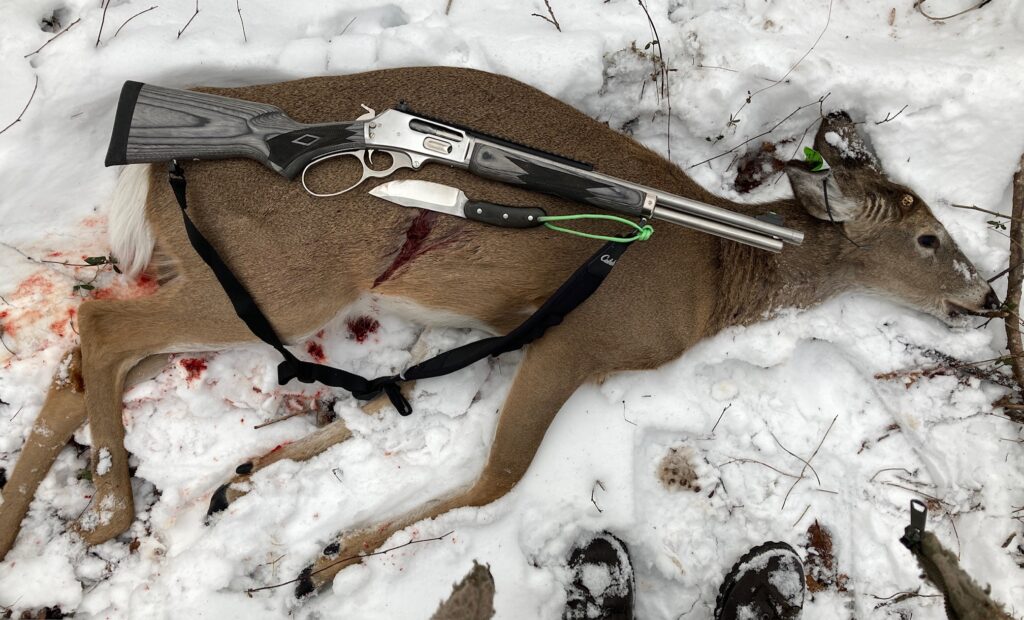
Deer I stalked and shot at 151 yards this week with the Marlin 1895 SBL. The 325-grain FTX bullet passed through lungs and stomach without slowing. Custom knife by JRJ John Johnson.
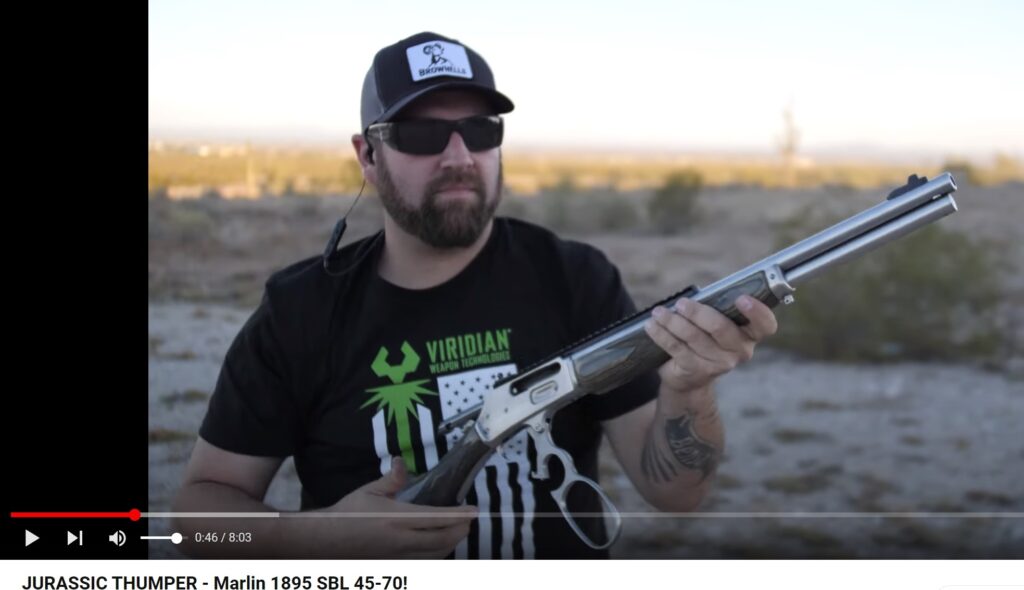
Exhibit A in macho gun reviews. Joe Cool shades in the shade. Biceps. Etc. Unfortunately, this rifle will not make his or your you-know-what bigger.

A 45-70 dangerous game round I loaded, using the 325-grain solid brass bullet by Cutting Edge Bullets. This is for stopping a grizzly
If you are going to hunt flintlock, you must practice, practice, practice
Flintlock hunting season ended in southeastern Pennsylvania two weeks ago, and for those hunters who had either not yet harvested a deer or, who, in the alternative, are usually highly successful, it was a last ditch chance to fill a doe tag or the unused buck tag. I know full well from my own feeling, as well as from hearing from other hunters similar to me, that despite having a good season (I killed four deer in two counties. One with a percussion rifle in October, two in rifle season with an open sight 308 Ruger RSI, and one with a flintlock in January), that sense of lost opportunity hangs pretty heavy. Perversely, the more successful a hunter is, the more successful he feels he must be with all remaining tags and opportunities.
In the old days (of my youth and long before then) that lost opportunity was called the “horse collar,” and however we might describe this nagging feeling, it can be a pretty tough driver. Guys (definitely guys only; women are too smart or doing too much real, important work to act this way) will just throw themselves into the late flintlock season hard. That unused tag weighs heavier and heavier as the season winds down, the deer get so much more skittish, and we feel the last opportunities to prove ourselves slipping through our cold gloved fingers.
On top of the usual limitations listed above, I unnecessarily handicapped myself badly before flintlock season started: I failed to practice shooting with my flintlock ahead of time. If there is one hard fact chiseled in granite about flintlocks that everyone knows, it is that they require regular practice in order to shoot them half decently. Especially before hunting big game with one. Not just because they require lots of little pieces of metal and a rock to all quickly and seamlessly work together to make the barrel go BOOM, but because a big flash of flame and smoke goes off right in the shooter’s face.
And that big flash in the powder pan in your face makes those people who have not practiced and become used to the flash flinch badly. It is natural to flinch your face away from a fiery explosion. And when you flinch, you are sure as shootin’ gonna miss. Hence the moniker “flinchlock.”
And flinch-miss I did this past late December and early January. A lot. Missed a deer in Lycoming County, missed a whole bunch of times in Dauphin County, including a dandy buck. In fact there was one doe I missed three times on three days in one week with two different flintlock rifles, all from close range. All because I had not practiced before the season.
When I finally did take a deer in the late season, it was because I had patterned him, a huge buck, all year, and I had just encountered his tracks and knew where he was likely to come in to investigate the smell of a late season doe in heat. And in fact he did show up, right where he should have come. At first he was just a faint shadow within many shadows in the big forest’s early morning half light.
I wasn’t even sure he was a deer when he first showed up. He just appeared, then stood behind trees, then behind a bush, looking around intently, never offering a good shot on his vitals. When he finally stepped into a shooting lane, I knew it was him only because of his enormous body and the improved daylight that let me take in the steer-like curves of his shoulders and hindquarters.
His huge 150 inch class antlers had prematurely dropped (which this year seemed to be the rule across northern and even parts of southern Pennsylvania), and then he, too, dropped. The round ball hit him square on the ribs and took out his lungs and the very top of his heart. After a late season of many misses, it is OK to admit that I only hit him because I had the rifle on a solid rest and I was seated. And that by that time I was not surprised when the flash went off with the BOOM of the rifle, but rather I was cool as hell and stayed looking straight down the barrel with good hold-through, watching him kick a few times through the smoke cloud that enveloped us both.
I do not name bucks, because it does not appeal to me to do so. But I still knew who this buck was from having encountered him several times over the past eight years. Several years ago I saw him twice in bear season, and his rack was good. In 2021 he came in to investigate some doe pee on a remote hillside, alongside a smaller deer with an unbelievably symmetrical ten point rack. I took the perfect rack and watched the bigger one run off. By January 2023 he had not an ounce of fat on his entire brute body whose hide will square twelve feet. He also had a huge rotting hole in one hoof (his hooves were each the size of my hand), and no teeth left on his jaw. This sagacious deer, whatever his name was, had attained the rarity of great grandfather status in the woods, and regardless of how cagey he was, his days were numbered. One way or another, he was destined to die soon.
Despite looking several times in the right places for his shed antlers, they did not show themselves. Possibly because a utility line right-of-way clearing crew had come through ahead of me. But who cares about finding his big antlers, right? His immense estimated ninety pounds of meat is right now feeding two families, and I shook off the horse collar from all the prior missing I had done.
Learn from my mistake: Practice, practice, practice with your flintlock before the season. And then the day before season opens, snap a couple of pans of priming powder on an empty barrel while aiming at a picture on the wall. Just to keep from flinching and missing.
And one more thing: Flintlock hunting attracts me intensely because it requires all of the skills a real hunter must have to be successful. Open sights, hold through, stealth and good wood craft, patience, etc. This is real hunting. There are no unethical lazy long range assassinations of unsuspecting wild game with a flintlock.
Oh, and one more thing: Apparently the Super Bowl starts soon. Super Bowl? Never heard of it. The NFL lost me a long time ago, in 2016 to be exact, with all of the anti America kneeling crap. And apparently tonight there is supposed to be yet another woke racial song sung at halftime. My time is worth much more to me than to spend it on and with such useless people as this. Instead of watching this game played by spoiled brats, I will be building a new work table.
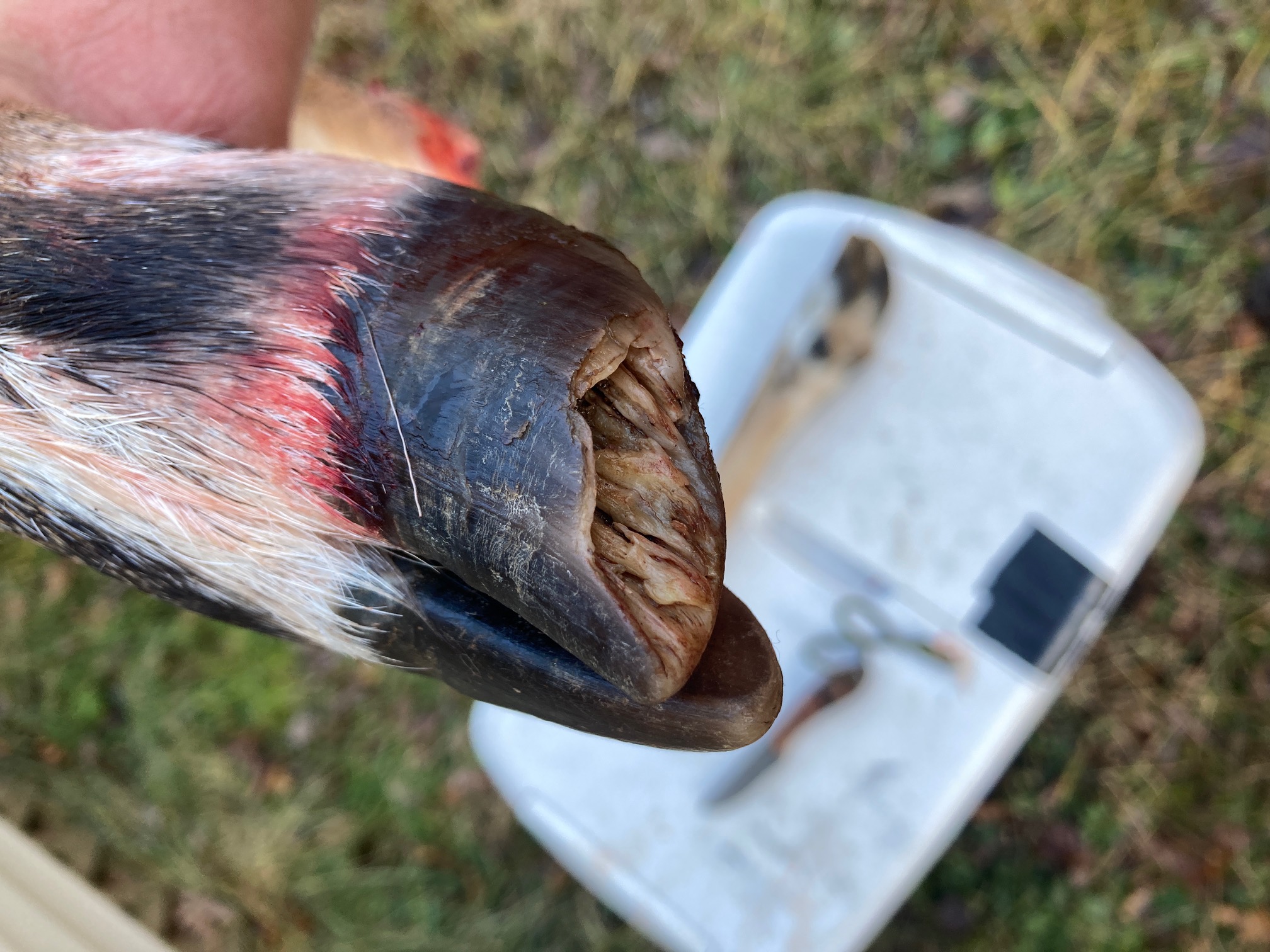
Huge old deer had weirdly rounded hooves and this big rotting hole in one hoof. His entire leg above this was enlarged, probably infected. All of his teeth were gone, completely worn down. His belly was full of grass, because he was unable to browse brush any longer.
Recent gun “buy backs” hugest waste of money and time
Leave it to people who are so consumed with hate that they can’t think straight to make a solid public policy, and so they expend public time and funds on really stupid things.
We are talking here about the hate that so many elected officials (99.5% of whom are registered Democrat Party) have for firearms. Firearms that otherwise secure our police forces, secure our armed forces, secure food for the table, and secure our private homes and personal bodies from violence. Firearms by themselves never did anything to anybody, but if you are an ineffective elected fool, and you are looking to make some kind of statement about how effective you are to people who are easily impressed, you do a “gun buy back.”
Such foolishness recently happened here in Northampton County, Pennsylvania and in Utica, New York.
Never mind that there is no “back” in the gun buy-back, because the guns being purchased never belonged to the official buyer. But hey, fools are gonna fool, especially with foolish sounding policy names, and so we get these mis-named public gun purchases in mostly Democrat-run towns and counties. *I grew up in a rural area where the Democrat Party was heavily represented. Today, not one person out there is a registered Democrat, because this political party has gone off the rails.
Public funds are expended to buy guns, with great fanfare and yet very little or no gain in public safety. Usually the public message goes something like this: “If our purchase of guns here today stops just one mistaken shooting, just one crime, just one accident, why then this is all worth it.”
Which is of course more foolish nonsense. The same communities are often wracked with violence and epidemic official failure, causing hundreds of local citizens to die unnecessarily and prematurely every year. But the “just one life” thing always sounds so serious.
Never does anyone ask What if these guns were used instead to defend our borders by state militia in Arizona, or New Mexico, or California, or Texas? Think about how many lives THAT would save, given how many drug and drug violence deaths are being walked across America’s open southern border right now. These guns in the hands of private citizens defending the American border could probably save hundreds of thousands of lives!
Or, what if the local police put on a gun safety program and taught these same private gun owners with little firearms experience how to safely shoot and store their guns? They would probably make their homes so much more safe and crime-resistant!
When all of the potentially saved lives are compared to the one or two potentially, theoretically, possibly saved by the “gun buy-back,” then we see these gun buy-backs a) don’t save lives and b) are a waste of public money.
What really strikes the eye in these publicized public firearm purchases are the purchased firearms’ low quality, the large number of antique black powder guns that have not hurt anyone since the 1860s, the valuable historic and collectible guns that should be sold to raise money for public agencies, and the simple hunting-grade weapons that leftists tell us they never ever want to take away from us. And all of the hunting ammunition! Destroying this stuff is the crime!
Why don’t the police use the ammunition for police officer training? Why destroy something so valuable as ammunition?!
And since when does the government rip off private citizens, paying them literally pennies on the dollar for high value guns, and then instead of monetizing that public money investment, the government employees then destroy the high value property?
Why doesn’t the government have an appraiser on site who can advise private citizens about the actual high value of the old gun the local government is offering them $75.00 for? Why is ripping off local people a good policy?
In Utica, New York, roughly $30,000.00 of public money was spent on purchasing… “ghost guns,” which is a political term, a loaded term, and a fake term to describe guns that are manufactured off the grid. And you know what? Those “ghost guns” that sound so dangerous and scary to the New York Attorney General… they were printed on a 3-D printer! In other words, they probably cost a few bucks each to make, and then the public mis-paid the owners hundreds of dollars each.
How does any of this make sense?
And yet all of these guns and the ammo are destined to be destroyed. So say the unquestioning mainstream media fools, who stand up in front of the cameras and parrot the talking points they are handed. Hint to the paid media people: You got a degree in “journalism,” I think because you were supposed to be…journalists? What kind of a journalist doesn’t ask questions, especially of those in positions of political and official power? (Answer is: Mainstream media people are not journalists and they do not ask questions. Instead they parrot narratives given to them by leftist government employees).
So we here are doing the job of the “journalists” who appeared in writing and on TV with the articles and reports about the gun purchases in Northampton County, PA, and Utica, NY. We are asking the simple questions, and making the simple points that these are not intelligent uses of official time or money. But then again, we do not begin at the assumption that destroying any and all firearms is the right and intelligent thing for government to do, because we are not filled up with mindless hate for inanimate objects.
[Question to the pro 2A activists in Northampton County: Why not sue this nincompoop of a DA, Terry Houck, and demand that he at least assess the market value of these guns before having them destroyed? In no other area of government do people get rewarded for destroying valuable public property]

Terry Houck is Northampton County’s idiot DA, who takes great pride in knowing zero about the collectible, valuable guns he is destroying
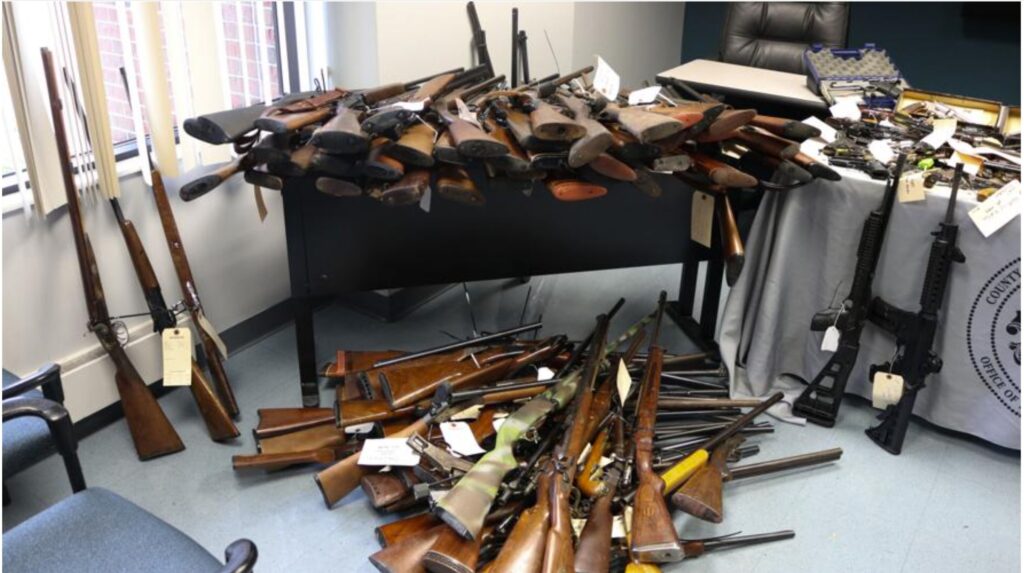
Flintlocks, black powder percussion guns, hunting shotguns, single shots, highly collectible and valuable Veteran bring-back guns from Europe, all said by DA Terry Houck to be dangerous. And yet…none of these are associated with crime. And therefore they are not dangerous.
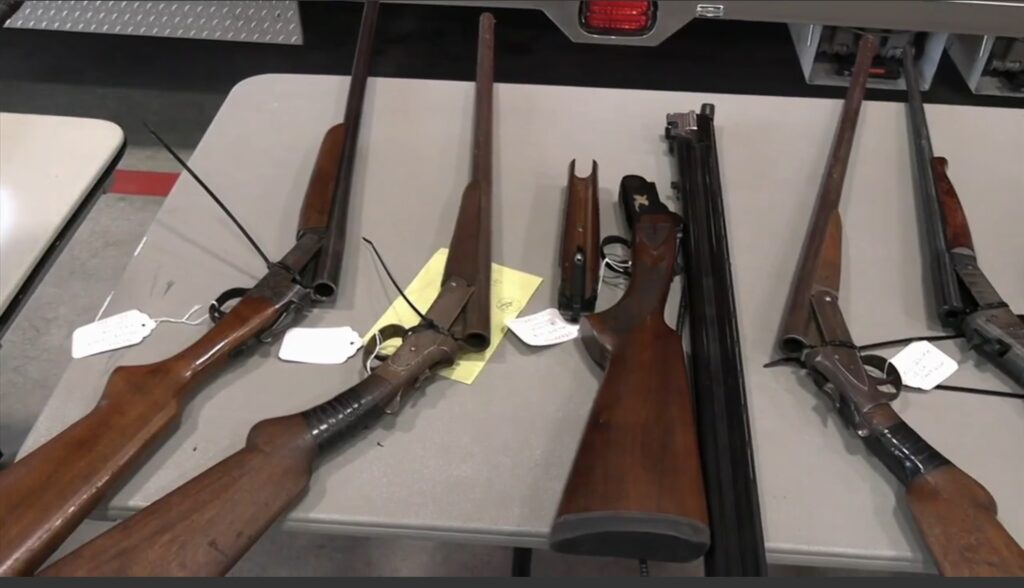
These are not the kinds of guns used in crime. Simple single shot shotguns and one really valuable over-under hunting shotgun, all destined to be destroyed. For no public benefit at all. Just to make fools feel good about themselves
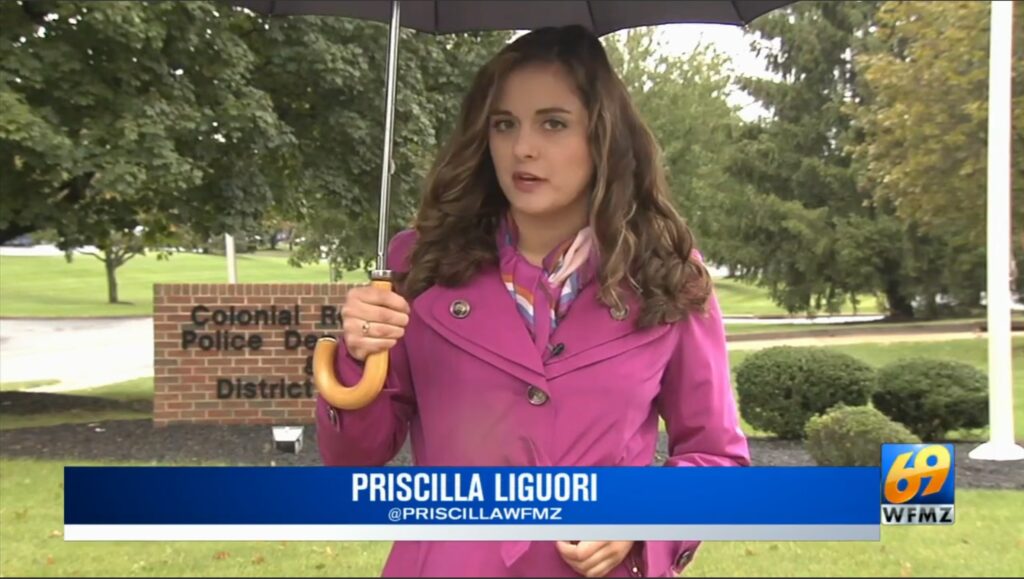
If you stand in front of a camera and talk like a parrot, are you a journalist? Priscilla Liguori asked no questions, committed no acts of journalism in the making of her report about Northampton County’s gun purchases. One more big mainstream media failure
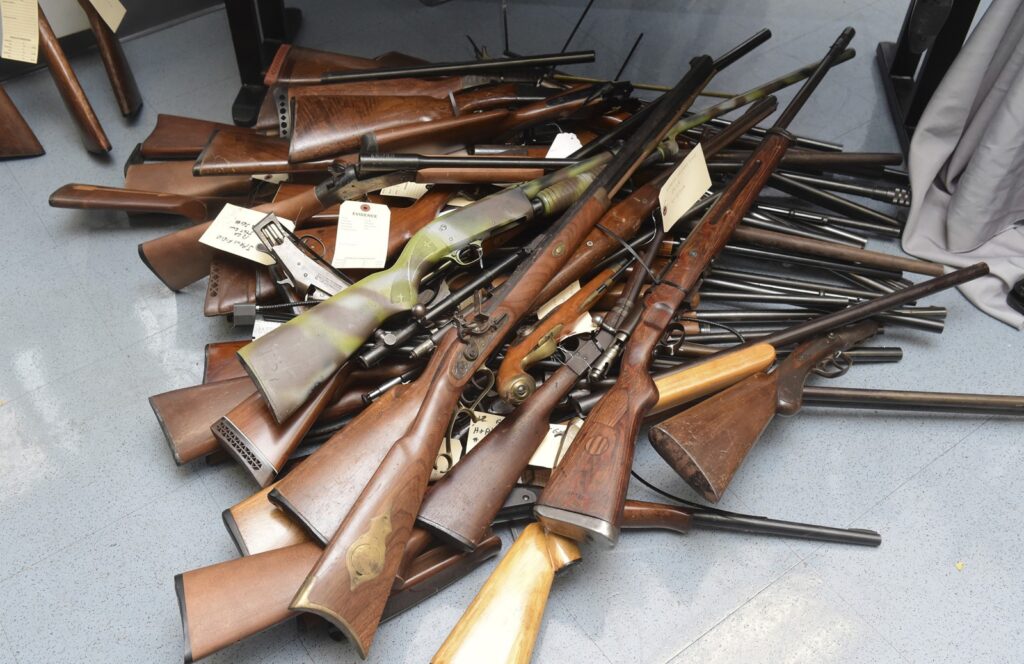
The green-colored gun is a Remington 20-gauge pump shotgun used for hunting birds and rabbits. The rifle at the far right bottom with the rounded pistol grip is a high value Veteran bring-back gun from Europe that never hurt anyone. The gun at the very top of the heap is a single shot black powder FLINTLOCK muzzleloader used to hunt deer; with 1790s technology, it has zero potential use in crime. Only hatred-filled firearm prohibitionists cheer on the destruction of these useful and safe recreational and collectible guns.
Primitive hunting techniques are more important than ever
In this day and age of popular stainless steel and plastic hunting rifles and Hubble telescope-sized rifle scopes, primitive hunting techniques and weapons are more important than ever. Something in the bad age of video games and instant gratification happened to the American character in the past thirty years or so, and so many young Americans have become lazy and even a bit heartless, as a result. Hunting culture has suffered from this, too. Really badly. Today’s focus seems to be predominantly on the kill, and much less on the process of the hunt.
Those curious about the distinction here should look up some neat videos from real hunters in the big woods of Vermont, Pennsylvania, and the Adirondacks.
Hunting should never be just about, or mostly about, killing an animal. Especially if the hunter wants to call it a trophy and put it up on his or her wall as a representation of his skill.
People trying to justify 300, 400 yard long range shots (or farther) on unsuspecting animals are not hunting, they are assassinating. Their wood craft often sucks, their field craft is limited to wearing camouflage, and their knowledge of the game animal is negligible. They are not really hunters, but rather shooters. Their high-tech guns, ammo, and rifle scopes are a crutch diminishing their need for good woodcraft, and it also results in a lack of appreciation for an actual hunt, and a lower value placed on the animal.
Culling oversized wild animal populations for the benefit of the environment is one thing, but hunting wild animals for pleasure and clean meat should be accomplished with skill. Age-old skills that everyone can respect. Hard-won wild animals taken with real skill under fair chase conditions are all trophies.
An unsuspecting big game animal assassinated at long range (or worse, inside a high fence, or over bait) requires very little hunting skill, and can never be said to be a trophy that is reflective of the hunter’s skill set. And yet isn’t this why so many hunters want big antlers and broad hides? They see these big animals as a reflection of their hunting prowess, of their manhood, their chest-thumping status within the outdoors community. As a result, America has developed a hunting culture driven by bigger-is-better trophies, at any cost, all too often achieved through long-range assassinations of unsuspecting wildlife, or over bait. Fair chase, which has always been at the heart of hunting, has been tossed away in favor of quick gratification and unfounded ego bragging rights.
The primary reason why primitive hunting weapons are so important today, is that someone has to keep the culture of hunting alive. What is a primitive hunting weapon? Pretty much any legal implement that requires the hunter to work hard to develop unique field craft/ wood craft skills, including the ability to penetrate within a fairly close range of the prey animal’s eyes, ears, and nose: Any bow (compound bow, stick bow, self bow, longbow, or other hand-held vertically limbed bow), spear, atl-atl, open-sighted black powder or centerfire rifle, any large bore handgun with or without a scope, should qualify. Flintlocks, percussion cap black powder muzzleloaders, and traditional bows are especially challenging to master and to harvest wild game with.
All of these primitive weapons require the hunter to actually hunt, to rely upon his woodcraft to carry him quietly and unseen across the landscape, and into a fair and close range of his prey animal. Animals taken with primitive weapons and techniques are earned in every way, and therefore they are fully appreciated.
Few experiences bother me more than watching some internet video of a fourteen year-old hunter running his hands over the antlers of a recently deceased buck, and listening to this inexperienced mere child discuss the finer aspects of this rack, its inches, its points, its relative size, and its (barf on my feet) trail camera name. Usually the child has shot the deer from an elevated box blind that conceals all of the hunter’s scent, sound, and movement. Whoever has taught these kids to hunt this way exclusively, and to then look at deer harvested this way as so many bragging rights, has done a huge disservice to these kids. These kids are going to grow up into poachers and baiters, always trying to prove how great of a “hunter” they are, and how studly and manly they are, at any cost. They will end up doing anything to score the next “record book” animal. These young kids who are being warped right now with this trophy nonsense are the future of America’s hunting culture, and what a crappy culture it will be if it is dominated by big egos and even bigger mouths armed with sniper rifles and no actual hunting skill.
Moms, dads, grandpas and uncles who are beginning to teach kids to hunt right now can do two simple things that will ensure their little student grows up into an ethical, responsible, high quality, law-abiding hunter: Make them use open sights on single-shot firearms and bows.
The skills that young hunters develop from having to rely on open sights and single shots (primitive weapons) will force them to achieve a high level of field craft, wood craft, and fair chase values. Developing skill requires a person to overcome challenges and adversity, often making mistakes along the way. And that results in better character.
Forcing kids to get close to their prey animal, and to take only carefully aimed shots with just open sights, will result in people who become really excellent hunters. Adults can always opt to add a scope to their rifle as their eyes age, but the lessons learned early on in concealment, controlling movement, playing wind direction, and instinctive shooting will keep the respectable art of hunting alive and well.
This Fall, get your little one started on a flintlock or old Fred Bear recurve bow from the get-go, for squirrels and deer, and watch as a true hunter is born.










